Sony KDL-40V3000: Start-up Guide
Start-up Guide: Sony KDL-40V3000
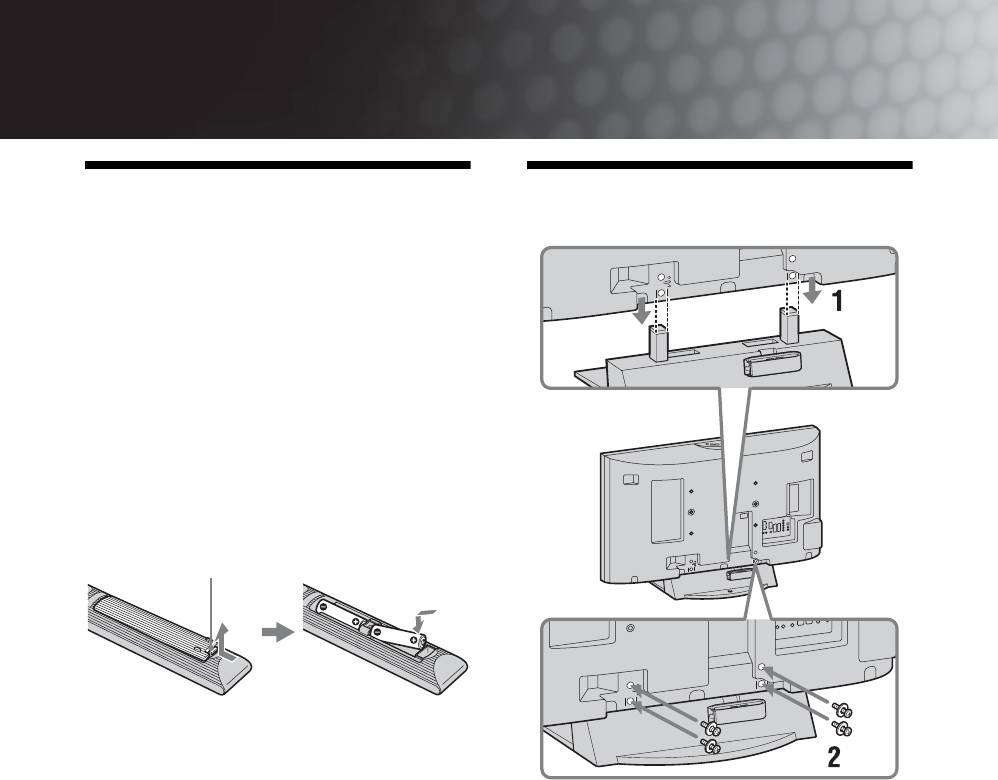
Start-up Guide
1: Checking the
2: Attaching the stand
accessories
Mains lead (Type C-6)* (1)
Coaxial cable (1)
Support belt (1) and screws (2)
Stand (1) and screws (4)
Remote RM-ED009 (1)
Size AA batteries (R6 type) (2)
* Do not remove the ferrite cores.
To insert batteries into the remote
Push and lift the cover to open.
~
• Observe the correct polarity when inserting batteries.
• Do not use different types of batteries together or mix old
and new batteries.
• Dispose of batteries in an environmentally friendly way.
1 Place the TV onto the stand by aligning the
Certain regions may regulate the disposal of batteries.
Please consult your local authority.
screw hole alignment lines over the stand
• Handle the remote with care. Do not drop or step on it, or
as shown.
spill liquid of any kind onto it.
• Do not place the remote in a location near a heat source, a
2 Fix the TV to the stand using the supplied
place subject to direct sunlight, or a damp room.
screws.
~
• This TV is very heavy, so two or more people should place
the TV on the stand.
• If using an electric screwdriver, set the tightening torque
at approximately 1.5 N·m (15 kgf·cm).
• When installing the TV onto the wall, follow step 1 to
prevent the TV panel from falling over.
GB
4
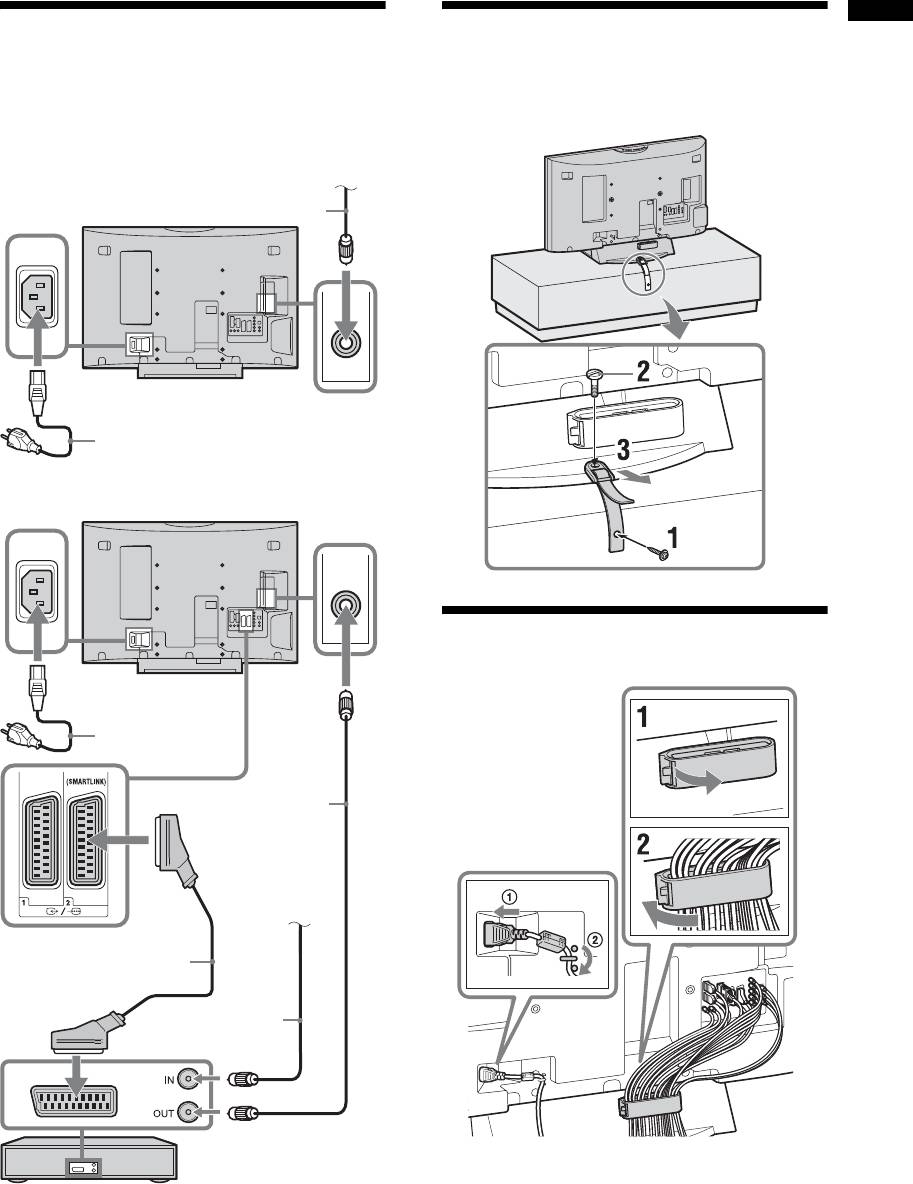
Start-up Guide
3: Connecting an aerial/
4: Preventing the TV
cable/VCR
from toppling over
Connecting an aerial/cable
Terrestrial signal or cable
Coaxial cable (supplied)
Mains lead (supplied)
Connecting an aerial/cable and VCR
5: Bundling the cables
Mains lead
(supplied)
Coaxial cable
(supplied)
Terrestrial signal
or cable
Scart lead (not supplied)
Coaxial cable
(not supplied)
VCR
~
The hook of the cable holder can be opened from either sides
depending on attaching position.
GB
5

4 Press F/f to select the country/region in
which you will operate the TV, then press
6: Performing the initial
.
setup
If the country/region which you want to use on the
TV does not appear in the list, select “-” instead of
a country/region.
Auto tuning the TV
5 Before you start auto tuning the TV, insert
a pre-recorded tape into the VCR
connected to the TV (page 5) and start play
3,4,6,7
back.
The video channel will be located and stored on
the TV during auto tuning.
9
If no VCR is connected to the TV, skip this step.
6 Press G/g to select “OK”, then press .
Selecting the language and country/
region
1 Connect the TV to your mains socket
(220-240 V AC, 50 Hz).
7 Press F/f to select “Antenna” or “Cable”,
2 Press 1 on the top edge of the TV.
then press .
When you turn on the TV for the first time, the
If you select “Cable”, the screen for selecting the
Language menu appears on the screen.
scan type appears. See “To tune the TV for digital
cable connection” on page 7.
3 Press F/f/G/g to select the language
The TV starts searching for all available digital
displayed on the menu screens, then press
channels, followed by all available analogue
.
channels. This may take some time, so do not
press any buttons on the TV or remote while
proceeding.
If a message appears for you to confirm the aerial
connection
No digital or analogue channels were found.
Check all the aerial connections and press to
start auto tuning again.
8 When the Programme Sorting menu
appears on the screen, follow the steps of
“Programme Sorting” on page 33.
If you do not wish to change the order in which the
analogue channels are stored on the TV, go to next
step.
GB
6
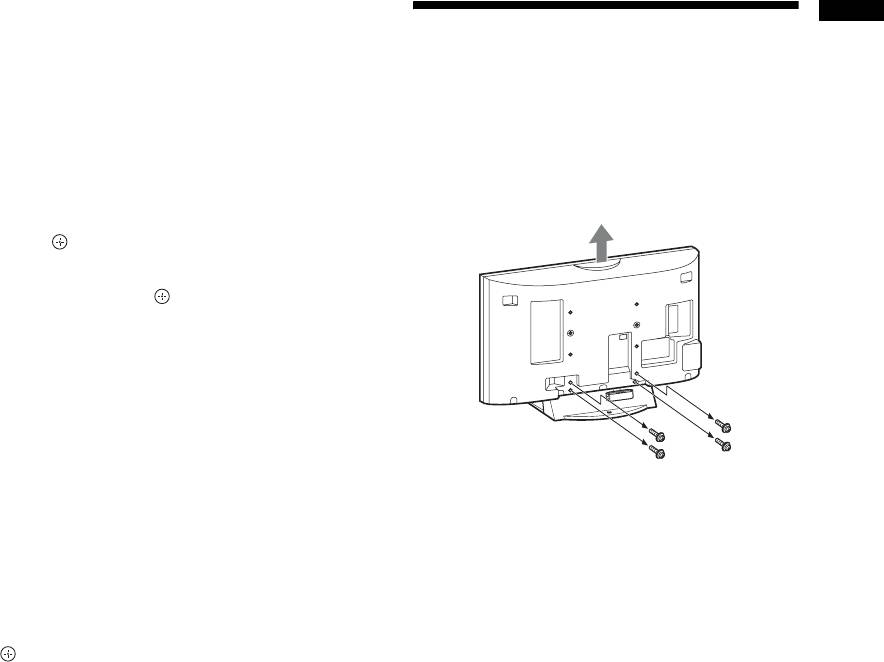
9 Press MENU to exit.
The TV has now tuned in all the available channels.
Start-up Guide
Detaching the stand
~
When a digital broadcast channel cannot be received, or
from the TV
when selecting a region in which there are no digital
broadcasts in step 4 (page 6), the time must be set after
performing step 9.
~
Do not remove the stand for any reason other than to wall-
mount the TV or to attach the optional TV stand.
To tune the TV for digital cable connection
1 Press F/f to select “Scan Type”, then
press .
2 Press F/f to select “Quick Scan” or “Full
Scan”, then press .
“Quick Scan”: Channels are tuned according to
the cable provider’s information within the
broadcast signal. The recommended setting for
“Frequency”, “Network ID” and “Symbol Rate” is
“Auto” unless your cable provider has supplied
actual values to use. “Quick Scan” is
recommended for fast tuning when this is
supported by your cable provider.
“Full Scan”: All available channels are tuned and
stored. This procedure may take some time. This
option is recommended when “Quick Scan” is not
supported by your cable provider.
For further information about supported cable
providers, refer to the support web site:
http://support.sony-europe.com/TV/DVBC/
3 Press G/g/f to select “Start”, then press
.
The TV starts searching for channels. Do not press
any buttons on the TV or remote.
~
Some cable providers do not support “Quick Scan”. If no
channels are detected using “Quick Scan”, perform “Full
Scan”.
GB
7
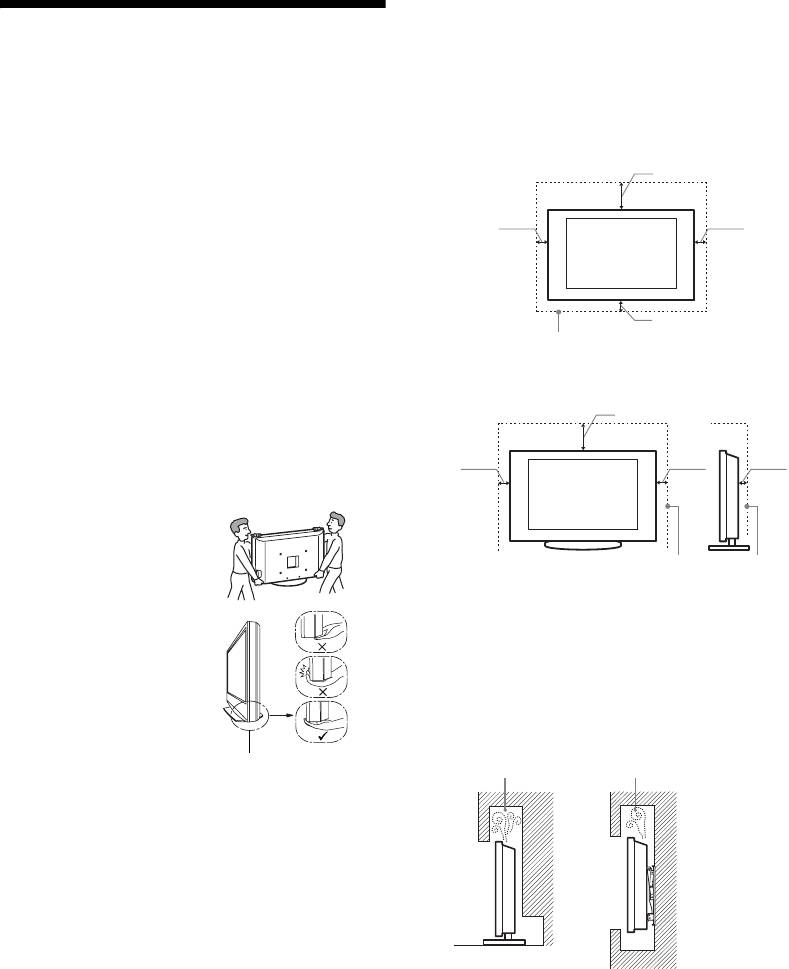
Ventilation
• Never cover the ventilation holes or insert anything in the
Safety information
cabinet.
• Leave space around the TV set as shown below.
• It is strongly recommended that you use a Sony wall-
mount bracket in order to provide adequate air-circulation.
Installation/Set-up
Installed on the wall
Install and use the TV set in accordance with the
instructions below in order to avoid any risk of fire,
30 cm
electrical shock or damage and/or injuries.
10 cm 10 cm
Installation
• The TV set should be installed near an easily accessible
mains socket.
• Place the TV set on a stable, level surface.
• Only qualified service personnel should carry out wall
installations.
10 cm
• For safety reasons, it is strongly recommended that you
Leave at least this space around the set.
use Sony accessories, including:
KDL-46V3000/40V3000:
– Wall-mount bracket SU-WL500
Installed with stand
KDL-46V3000/40V3000:
30 cm
– Floor stand SU-FL62
KDL-46V3000/40V3000:
– TV stand SU-FL300M
10 cm 10 cm 6 cm
Transporting
• Before transporting the
TV set, disconnect all
cables.
Leave at least this space around the set.
• Two or three people are
needed to transport a large
• To ensure proper ventilation and prevent the collection of
TV set.
dirt or dust:
• When transporting the TV
– Do not lay the TV set flat, install upside down,
set by hand, hold it as
backwards, or sideways.
shown on the right. Do not
– Do not place the TV set on a shelf, rug, bed or in a
put stress on the LCD
closet.
panel.
– Do not cover the TV set with a cloth, such as curtains,
• When lifting or moving
or items such as newspapers, etc.
the TV set, hold it firmly
– Do not install the TV set as shown below.
from the bottom.
Be sure to hold the
• When transporting the TV
Air circulation is blocked.
bottom of the panel, not
set, do not subject it to
jolts or excessive
the front part.
vibration.
• When transporting the TV
set for repairs or when
moving, pack it using the
Wall Wall
original carton and
packing material.
GB
8
Mains lead
When not in use
Handle the mains lead and socket as follows in order
• If you will not be using the TV set for several days, the TV
to avoid any risk of fire, electrical shock or damage
set should be disconnected from the mains for
environmental and safety reasons.
and/or injuries:
• As the TV set is not disconnected from the mains when the
– Connect the TV set using a three-wire grounding type
TV set is just turned off, pull the plug from the mains to
mains plug to a mains socket with a protective earthing
disconnect the TV set completely.
connection.
• However, some TV sets may have features that require the
– Use only Sony mains leads, not those of other brands.
TV set to be left in standby to work correctly.
– Insert the plug fully into the mains socket.
– Operate the TV set on a 220-240 V AC supply only.
– When wiring cables, be sure to unplug the mains lead
for your safety and take care not to catch your feet on
For children
the cables.
• Do not allow children to climb on the TV set.
– Disconnect the mains lead from the mains socket before
• Keep small accessories out of the reach of children, so that
working on or moving the TV set.
they are not mistakenly swallowed.
– Keep the mains lead away from heat sources.
– Unplug the mains plug and clean it regularly. If the plug
is covered with dust and it picks up moisture, its
insulation may deteriorate, which could result in a fire.
If the following problems occur...
Turn off the TV set and unplug the mains lead
Notes
immediately if any of the following problems occur.
• Do not use the supplied mains lead on any other
Ask your dealer or Sony service centre to have it
equipment.
checked by qualified service personnel.
• Do not pinch, bend, or twist the mains lead excessively.
The core conductors may be exposed or broken.
When:
• Do not modify the mains lead.
– Mains lead is damaged.
• Do not put anything heavy on the mains lead.
– Poor fitting of mains socket.
• Do not pull on the mains lead itself when disconnecting
– TV set is damaged by being dropped, hit or having
the mains lead.
something thrown at it.
• Do not connect too many appliances to the same mains
– Any liquid or solid object falls through openings in the
socket.
cabinet.
• Do not use a poor fitting mains socket.
Prohibited Usage
Do not install/use the TV set in locations,
environments or situations such as those listed below,
or the TV set may malfunction and cause a fire,
electrical shock, damage and/or injuries.
Location:
Outdoors (in direct sunlight), at the seashore, on a ship or
other vessel, inside a vehicle, in medical institutions,
unstable locations, near water, rain, moisture or smoke.
Environment:
Places that are hot, humid, or excessively dusty; where
insects may enter; where it might be exposed to mechanical
vibration, near flammable objects (candles, etc). The TV set
shall not be exposed to dripping or splashing and no objects
filled with liquids, such as vases, shall be placed on the TV.
Situation:
Do not use when your hands are wet, with the cabinet
removed, or with attachments not recommended by the
manufacturer. Disconnect the TV set from mains socket and
aerial during lightning storms.
Broken pieces:
• Do not throw anything at the TV set. The screen glass may
break by the impact and cause serious injury.
• If the surface of the TV set cracks, do not touch it until you
have unplugged the mains lead. Otherwise electric shock
may result.
GB
9

Precautions
Viewing the TV
• View the TV in moderate light, as viewing the TV in poor
light or during long period of time, strains your eyes.
• When using headphones, adjust the volume so as to avoid
excessive levels, as hearing damage may result.
LCD Screen
• Although the LCD screen is made with high-precision
technology and 99.99% or more of the pixels are effective,
black dots may appear or bright points of light (red, blue,
or green) may appear constantly on the LCD screen. This
is a structural property of the LCD screen and is not a
malfunction.
• Do not push or scratch the front filter, or place objects on
top of this TV set. The image may be uneven or the LCD
screen may be damaged.
• If this TV set is used in a cold place, a smear may occur in
the picture or the picture may become dark. This does not
indicate a failure. These phenomena disappear as the
temperature rises.
• Ghosting may occur when still pictures are displayed
continuously. It may disappear after a few moments.
• The screen and cabinet get warm when this TV set is in
use. This is not a malfunction.
• The LCD screen contains a small amount of liquid crystal
and mercury. The fluorescent tubes used in this TV set
also contain mercury. Follow your local ordinances and
regulations for disposal.
Handling and cleaning the screen surface/cabinet of
the TV set
Be sure to unplug the mains lead connected to the TV set
from mains socket before cleaning.
To avoid material degradation or screen coating degradation,
observe the following precautions.
• To remove dust from the screen surface/cabinet, wipe
gently with a soft cloth. If dust is persistent, wipe with a
soft cloth slightly moistened with a diluted mild detergent
solution.
• Never use any type of abrasive pad, alkaline/acid cleaner,
scouring powder, or volatile solvent, such as alcohol,
benzene, thinner or insecticide. Using such materials or
maintaining prolonged contact with rubber or vinyl
materials may result in damage to the screen surface and
cabinet material.
• When adjusting the angle of the TV set, move it slowly so
as to prevent the TV set from moving or slipping off from
its table stand.
Optional Equipment
Keep optional components or any equipment emitting
electromagnetic radiation away from the TV set. Otherwise
picture distortion and/or noisy sound may occur.
GB
10
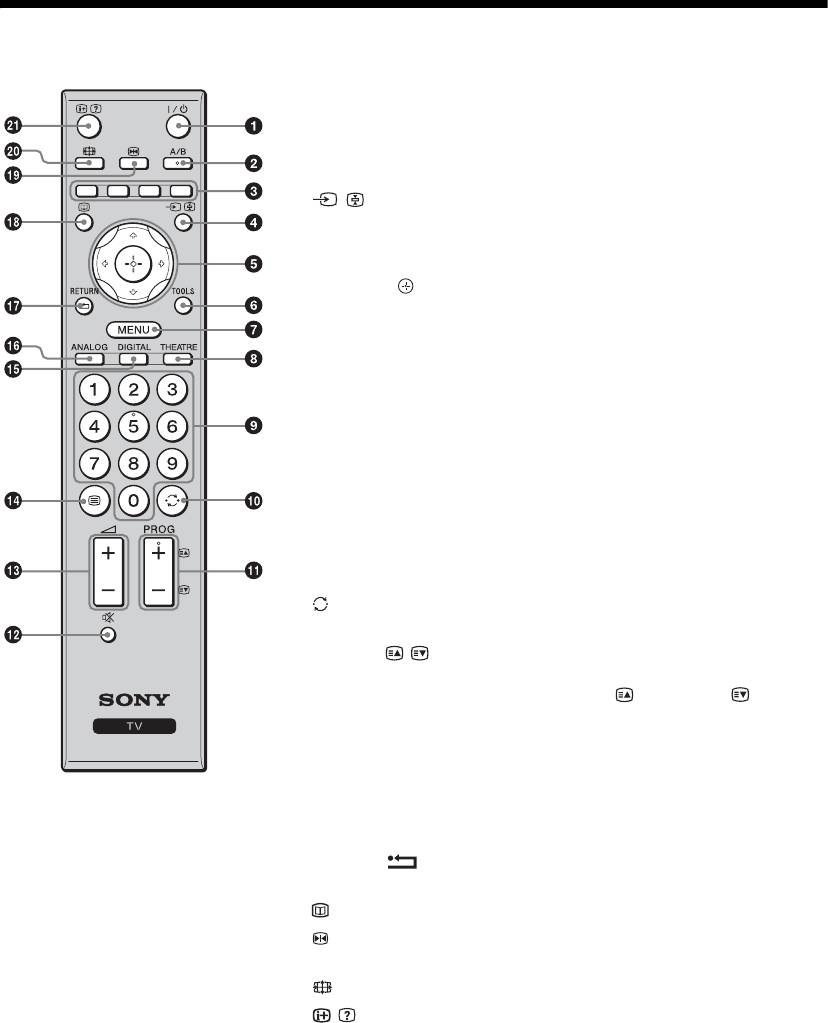
Overview of the remote
1 "/1 – TV standby
Turns the TV on and off from standby mode.
2 A/B – Dual Sound (page 26)
3 Coloured buttons (page 14, 15, 17)
4 / – Input select / Text hold
• In TV mode (page 20): Selects the input source from equipment connected
to the TV sockets.
• In Text mode (page 14): Holds the current page.
5 F/f/G/g/ (page 13, 22)
6 TOOLS (page 14, 20)
Enables you to access various viewing options and change/make adjustments
according to the source and screen format.
7 MENU (page 22)
8 THEATRE
You can set Theatre Mode on or off. When Theatre Mode is set to on, the
optimum audio output (if the TV is connected with an audio system using an
HDMI cable) and picture quality for film-based contents are automatically
set.
9 Number buttons
• In TV mode: Selects channels. For channel numbers 10 and above, enter
the second and third digit quickly.
• In Text mode: Enters the three digit page number to select the page.
0 – Previous channel
Returns to the previous channel watched (for more than five seconds).
qa PROG +/-/ /
• In TV mode (page 13): Selects the next (+) or previous (-) channel.
• In Text mode (page 14): Selects the next ( ) or previous ( ) page.
qs % – Mute (page 13, 20)
qd 2 +/- – Volume (page 20)
qf / – Text (page 14)
qg DIGITAL – Digital mode (page 13)
z
qh ANALOG – Analogue mode (page 13)
• The number 5, PROG + and A/B
qj RETURN /
buttons have tactile dots. Use the tactile
Returns to the previous screen of any displayed menu.
dots as references when operating the
TV.
qk – EPG (Digital Electronic Programme Guide) (page 15)
• If you turn the TV off, Theatre Mode is
ql – Picture freeze (page 13)
also turned off.
Freezes the TV picture.
w; – Screen mode (page 14)
wa / – Info / Text reveal
• In digital mode: Displays brief details of the programme currently being
watched.
• In analogue mode: Displays information such as current channel number
and screen format.
• In Text mode (page 14): Reveals hidden information (e.g. answers to a
quiz).
GB
11
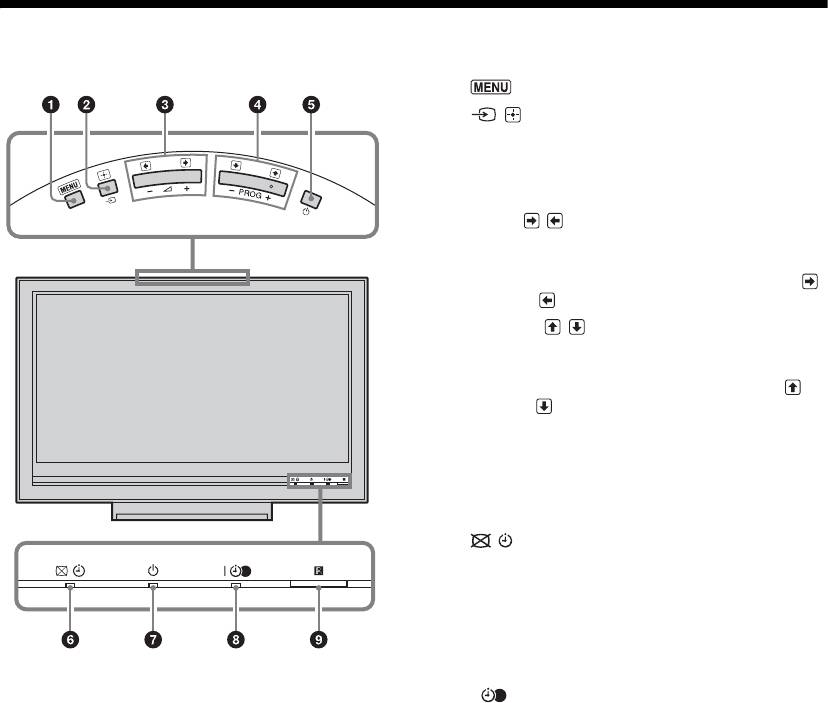
Overview of the TV buttons and indicators
1 (page 22)
2 / – Input select / OK
• In TV mode (page 20): Selects the input source
from equipment connected to the TV sockets.
• In TV menu: Selects the menu or option, and
confirms the setting.
3 2 +/-/ /
• In TV mode: Increases (+) or decreases (-) the
volume.
• In TV menu: Moves through the options right ( )
or left ( ).
4 PROG +/-/ /
• In TV mode: Selects the next (+) or previous (-)
channel.
• In TV menu: Moves through the options up ( ) or
down ( ).
5 1 – Power
Turns the TV on or off.
~
To disconnect the TV completely, pull the plug from the
mains.
6 – Picture Off / Timer indicator
• Lights up in green when the picture is switched off
(page 30).
• Lights up in orange when the timer is set
(page 30).
7 1 – Standby indicator
Lights up in red when the TV is in standby mode.
8 " – Power / Timer REC programme indicator
• Lights up in green when the TV is turned on.
• Lights up in orange when the timer recording is set
(page 15).
• Lights up in red during the timer recording.
9 Remote control sensor / Light sensor (page 31)
• Receives IR signals from the remote.
• Do not put anything over the sensor, as its function
may be affected.
~
Make sure that the TV is completely turned off before
unplugging the mains lead. Unplugging the mains lead while
the TV is turned on may cause the indicator to remain lit or
may cause the TV to malfunction.
GB
12
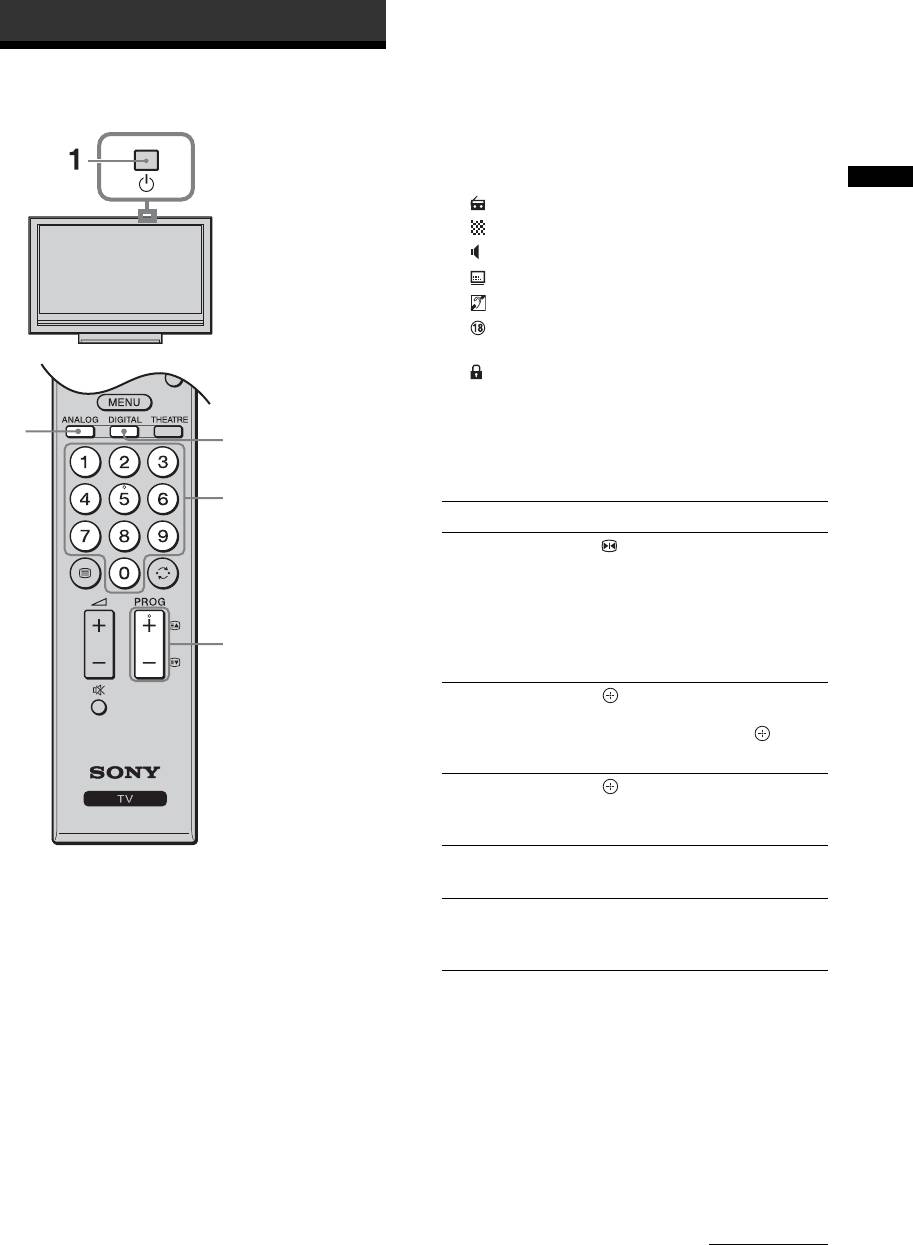
Watching TV
To select a digital channel using the Digital
Watching TV
Electronic Programme Guide (EPG), see page 15.
In digital mode
An information banner appears briefly. The
following icons may be indicated on the banner.
: Radio service
Watching TV
: Scrambled/Subscription service
: Multiple audio languages available
: Subtitles available
: Subtitles available for the hearing impaired
: Recommended minimum age for current
programme (from 4 to 18 years)
: Parental Lock
c (in red):
Current programme is being recorded
2
2
Additional operations
3
To Press
Freeze the picture
.
(Picture freeze)
Press once to remove the small
screen, then press again to return
to normal TV mode.
~
This function is not available for a
3
PC input source.
Access the
.
Programme index
To select an analogue channel,
table (in analogue
press
F/f, then press .
mode only)
Access the Digital
.
Favourites (in digital
For details, see page 17.
mode only)
Mute the sound %.
1 Press 1 on the top edge of the TV to turn
Press again to restore.
on the TV.
Turn on the TV
%.
When the TV is in standby mode (the 1 (standby)
without sound from
indicator on the TV front panel is red), press "/1
standby mode
on the remote to turn on the TV.
2 Press DIGITAL to switch to digital mode, or
press ANALOG to switch to analogue
mode.
The channels available vary depending on the
mode.
3 Press the number buttons or PROG +/- to
select a TV channel.
To select channel numbers 10 and above using the
number buttons, enter the second and third digits
quickly.
Continued
GB
13
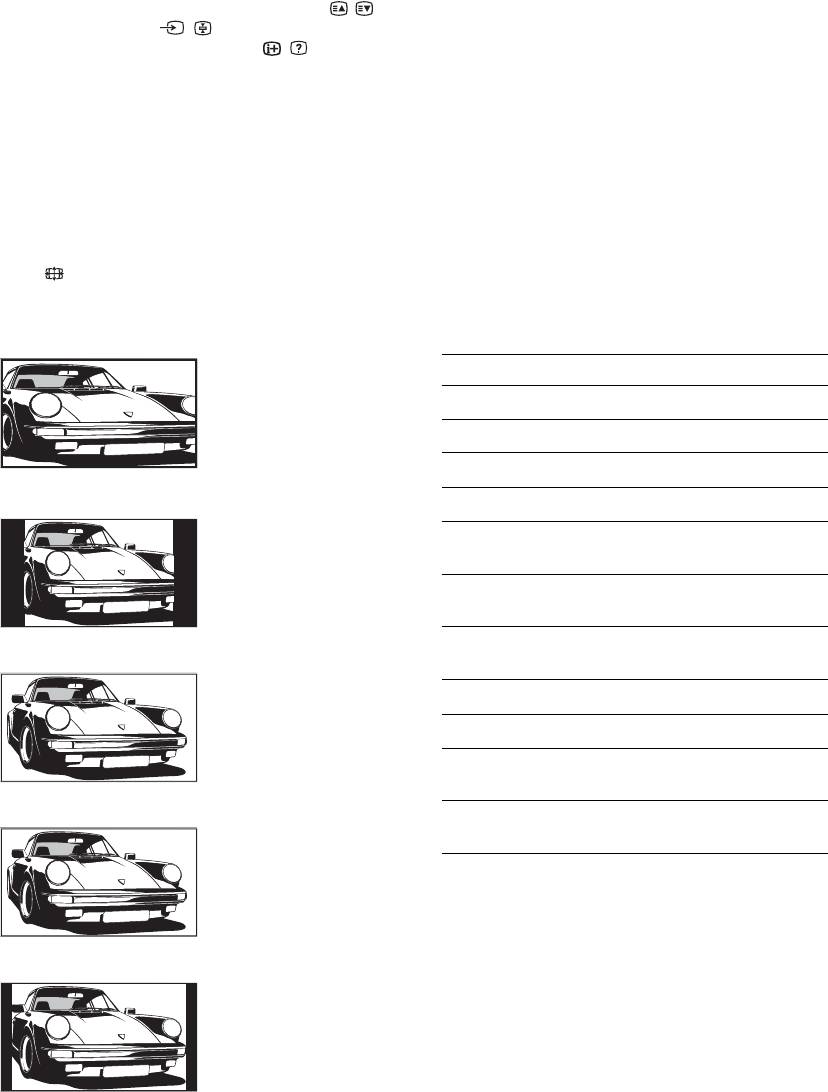
To access Text
~
• You cannot select “4:3” or “14:9” for HD signal source
Press /. Each time you press /, the display changes
pictures.
cyclically as follows:
• You cannot use this function while the digital banner is
Text t Text over the TV picture (mix mode) t No
displayed.
Text (exit the Text service)
• Some characters and/or letters at the top and the bottom of
To select a page, press the number buttons or / .
the picture may not be visible in “Smart”. In such a case,
To hold a page, press / .
you can select “Vertical Size” using the “Screen” menu
To reveal hidden information, press / .
and adjust vertical size to make it visible.
z
• When “Auto Format” is set to “On”, the TV will
z
automatically select the best mode to suit the broadcast
When four coloured items appear at the bottom of the Text
(page 27).
page, Fastext is available. Fastext allows you to access pages
• You can adjust the position of the picture when selecting
quickly and easily. Press the corresponding coloured button
“Smart” (50Hz), “Zoom” or “14:9”. Press
F/f to move
to access the page.
up or down (e.g. to read subtitles) (except 720p and
1080i).
• Select “Smart” or “Zoom” to adjust for 720p or 1080i
To change the screen format manually to
source pictures with edge portions cut off.
suit the broadcast
Press repeatedly to select the desired screen
format.
Using the Tools menu
Press TOOLS to display the following options when
viewing a TV programme.
Smart*
Displays conventional
Options Description
4:3 broadcasts with an
Close Closes the Tools menu.
imitation wide screen
effect. The 4:3 picture
Picture Mode See page 23.
is stretched to fill the
screen.
Sound Mode See page 25.
4:3
Speaker See page 29.
Displays conventional
Audio Language (in
See page 37.
4:3 broadcasts (e.g.
digital mode only)
non-wide screen TV) in
the correct proportions.
Subtitle Setting (in
See page 37.
digital mode only)
i Volume Adjusts the volume of the
Wide
headphones.
Displays wide screen
Sleep Timer See page 30.
(16:9) broadcasts in the
correct proportions.
Power Saving See page 30.
Auto Clock Set (in
Allows you to switch to digital
analogue mode only)
mode and obtain the time.
Zoom*
System Information (in
Displays the system
Displays cinemascopic
digital mode only)
information screen.
(letter box format)
broadcasts in the
correct proportions.
14:9*
Displays 14:9
broadcasts in the
correct proportions. As
a result, black border
areas are visible on the
screen.
* Parts of the top and bottom of the picture may be cut off.
GB
14
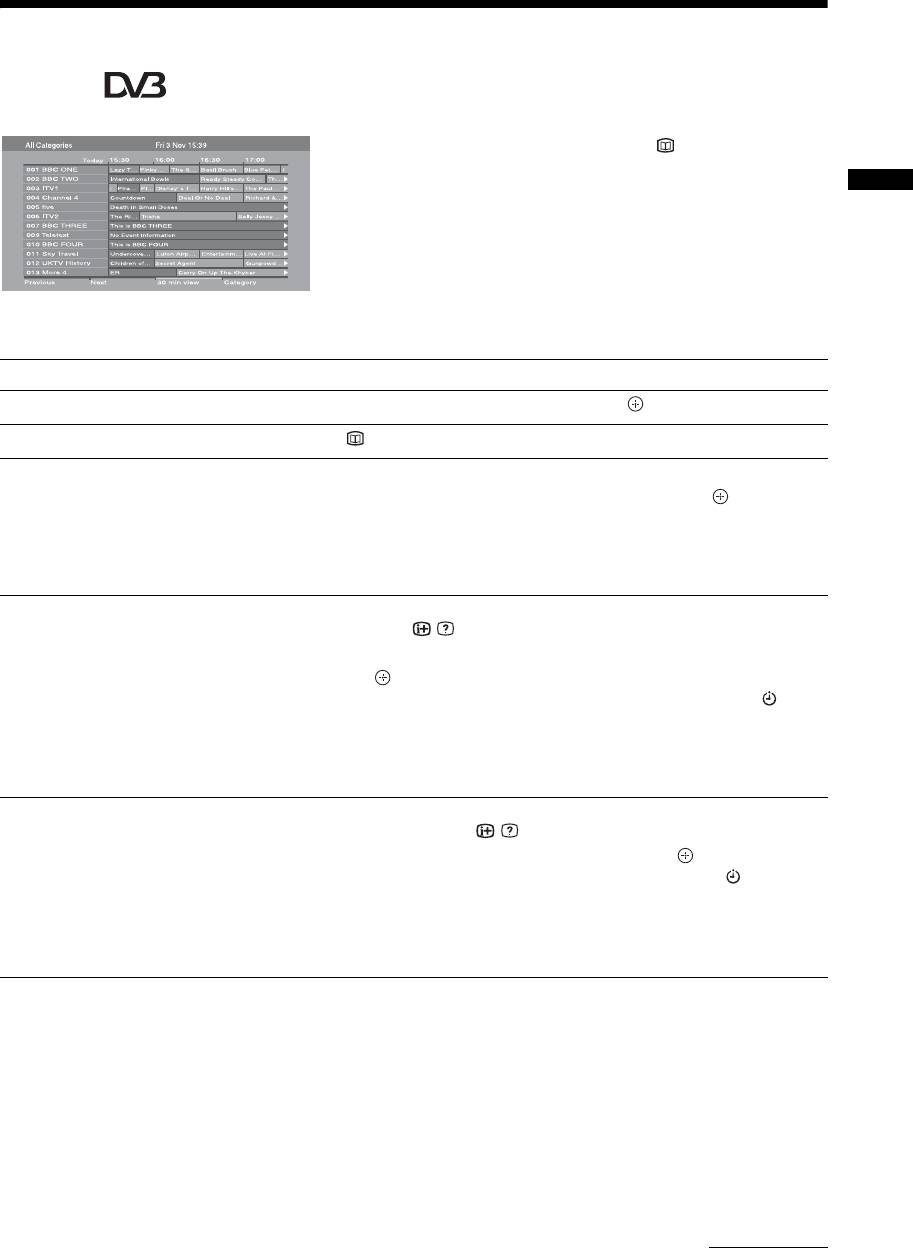
Checking the Digital Electronic Programme Guide
(EPG) *
1 In digital mode, press .
2 Perform the desired operation as shown in
the following table or displayed on the
Watching TV
screen.
Digital Electronic Programme Guide (EPG)
* This function may not be available in some countries/regions.
To Do this
Watch a programme Press F/f to select the programme, then press .
Turn off the EPG Press .
Sort the programme information by
1 Press the blue button.
category
2 Press
F/f/G/g to select a category, then press .
– Category list
The categories available include:
“All Categories”: Contains all available channels.
Category name (e.g. “News”): Contains all channels corresponding to the
selected category.
Set a programme to be recorded
1 Press F/f/G/g to select the programme you want to record,
– Timer REC
then press
/ .
2 Press
F/f to select “Timer REC”.
3 Press to set the TV and your VCR timers.
A red c symbol appears by that programme’s information. The
indicator on the TV front panel lights up in orange.
z
The above procedure can be used even if the programme to be recorded has already
started.
Set a programme to be displayed
1 Press F/f/G/g to select the future programme you want to
automatically on the screen when it
display, then press / .
starts
2 Press
F/f to select “Reminder”, then press .
– Reminder
A c symbol appears by that programme’s information. The indicator on
the TV front panel lights up in orange.
~
If you switch the TV to standby mode, it will automatically turn itself on
when the programme is about to start.
Continued
GB
15
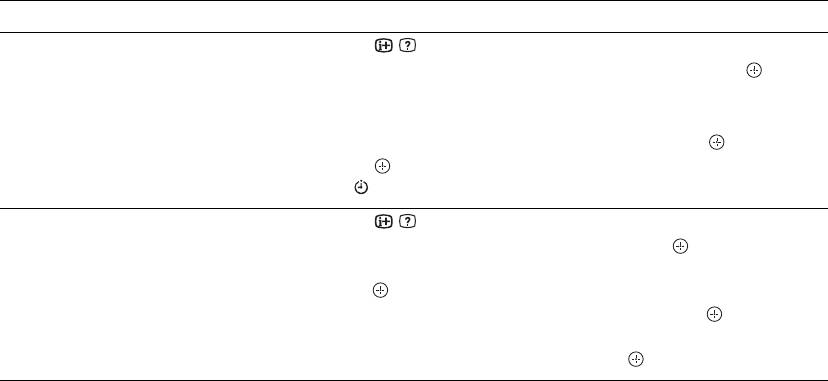
To Do this
Set the time and date of a programme
1 Press / .
you want to record
2 Press
F/f to select “Manual timer REC”, then press .
– Manual timer REC
3 Press
F/f to select the date, then press g.
4 Set the start and stop time in the same way as in step 3.
5 Press
F/f to select the programme, then press .
6 Press to set the TV and your VCR timers.
The indicator on the TV front panel lights up in orange.
Cancel a recording/reminder
1 Press / .
– Timer list
2 Press
F/f to select “Timer list”, then press .
3 Press
F/f to select the programme you want to cancel, then
press .
4 Press
F/f to select “Cancel Timer”, then press .
A display appears to confirm that you want to cancel the programme.
5 Press G/g to select “Yes”, then press to confirm.
~
• You can set VCR timer recording on the TV only for SmartLink compatible VCRs. If your VCR is not SmartLink compatible,
a message will be displayed to remind you to set your VCR timer.
• Once a recording has begun, you can switch the TV to standby mode, but do not turn off the TV completely or the recording
will be cancelled.
• If an age restriction for programmes has been selected, a message asking for a PIN code will appear on the screen. For details,
see “Parental Lock” on page 37.
GB
16

Using the Digital Favourite list *
The Favourite feature allows you to specify up to four
lists of your favourite programmes.
1 Press MENU.
2 Press F/f to select “Digital Favourites”,
then press .
Watching TV
3 Perform the desired operation as shown in
Digital Favourite list
the following table or displayed on the
* This function may not be available in some countries/
screen.
regions.
z
Up to 999 channels can be stored in the Favourite list.
To Do this
Create your Favourite list for the first
1 Press to select “Yes”.
time
2 Press the yellow button to select the Favourite list.
3 Press
F/f to select the channel you want to add, then press .
Channels that are stored in the Favourite list are indicated by a symbol.
Watch a channel
1 Press the yellow button to navigate through your Favourite lists.
2 Press while selecting a channel.
Turn off the Favourite list Press RETURN.
Add or remove channels in the currently
1 Press the blue button.
edited Favourite list
2 Press the yellow button to select the Favourite list you want to
edit.
3 Press
F/f to select the channel you want to add or remove,
then press .
Remove all channels from the current
1 Press the blue button.
Favourite list
2 Press the yellow button to select the Favourite list you want to
edit.
3 Press the blue button.
4 Press
G/g to select “Yes”, then press to confirm.
GB
17

Using Optional Equipment
Connecting optional equipment
You can connect a wide range of optional equipment to your TV.
Audio system
PC
DVD player
DVD player with component output
PC (HDMI output)
Blu-ray disc player
Digital audio (PCM)
component
Hi-Fi audio
equipment
Video game equipment
DVD recorder
DVD player
VCR
Decoder
Decoder
Headphones
For service use only
Camcorder
CAM Card
PC (HDMI output)
Blu-ray disc player
Camcorder
Audio system
DVD player
GB
18
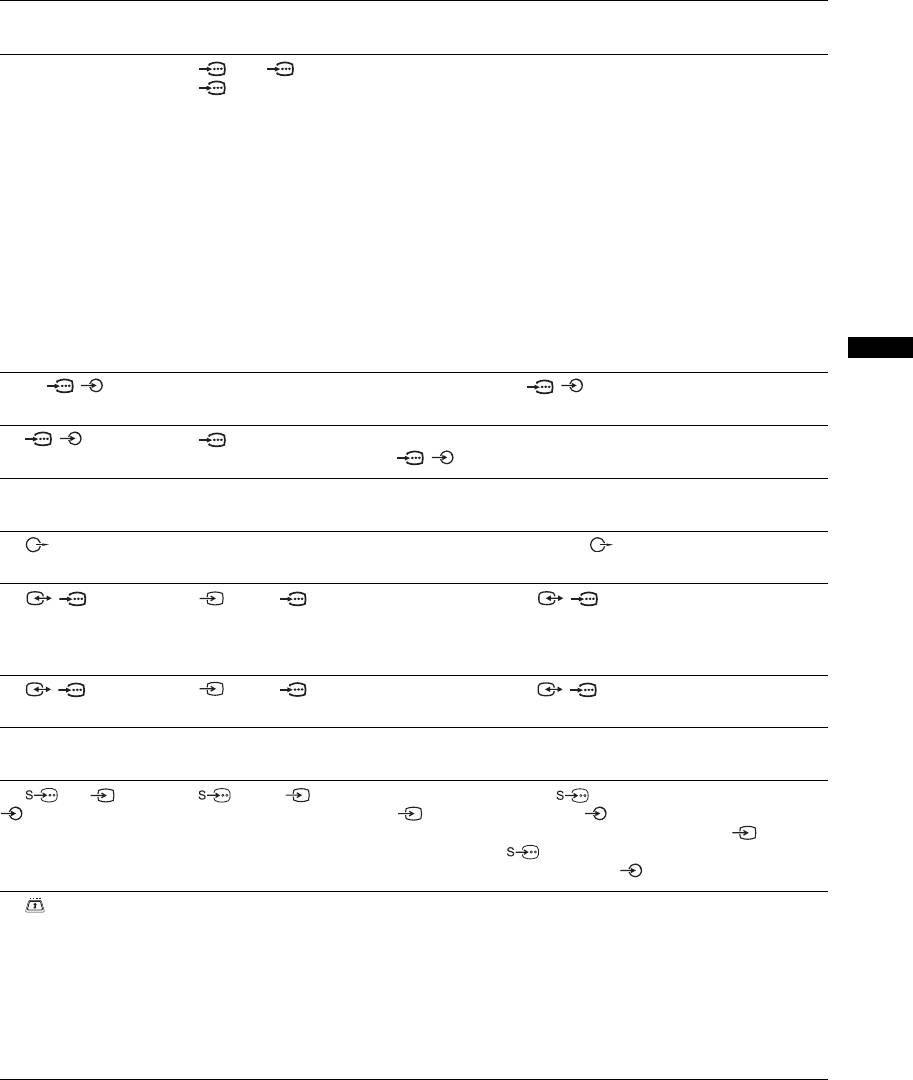
Sockets Input symbol on
Description
screen
A HDMI IN 4 or 5
AV4, AV5 or
Connect to the HDMI IN 4, 5 or 7 socket if the equipment has a
J HDMI IN 7
AV 7
HDMI socket. The digital video and audio signals are input
from the equipment. In addition, when HDMI control
compatible equipment is connected, communication with the
connected equipment is supported. Refer to page 30 to set up
this communication. If the equipment has a DVI socket,
connect the DVI socket to the HDMI IN 5 socket through a
DVI - HDMI adaptor interface (not supplied), and connect the
equipment’s audio out sockets to the audio in the HDMI IN 5
sockets.
~
• The HDMI sockets only support the following video inputs: 480i,
480p, 576i, 576p, 720p, 1080i, 1080p and 1080/24p.
• Be sure to use only an HDMI cable that bears the HDMI logo.
• When connecting an audio system with HDMI socket, be sure to
also connect to the DIGITAL OUT socket.
Using Optional Equipment
B PC / PC Connect to the PC / socket. It is recommended to use a
PC cable with ferrites.
C / 3 AV3 Connect to the component video sockets and the audio sockets
/3.
D DIGITAL OUT
Connect to the DIGITAL OUT socket using the Optical audio
(OPTICAL)
cable.
E Connect to the audio output sockets to listen to the sound
from the TV on Hi-Fi audio equipment.
F / 1 AV1 or AV1 Connect to the scart / 1 socket. When you connect the
decoder, the scrambled signal from the TV tuner is output to
the decoder, then the unscrambled signal is output from the
decoder.
G / 2 AV2 or AV2 Connect to the scart / 2 socket. SmartLink is a direct
link between the TV and a VCR/DVD recorder.
H Headphones Connect to the i socket to listen to sound from the TV on
headphones.
I 6 or 6, and
AV6 or AV6 Connect to the S video 6 socket or the composite video
6
6 socket, and the audio 6 sockets. To avoid picture
noise, do not connect the camcorder to the video 6 socket
and the S video 6 socket at the same time. If you connect
mono equipment, connect to the 6 L socket.
K CAM
To use pay TV services. For details, refer to the instruction
(Conditional Access
manual supplied with your CAM.
Module)
To use the CAM, remove the “dummy” card from the CAM
slot. Turn off the TV when inserting your CAM into the CAM
slot. When you do not use the CAM, we recommend that the
“dummy” card be inserted and kept in the CAM slot.
~
CAM is not supported in some countries/regions. Check with your
authorized dealer.
GB
19

Using the Tools menu
Press TOOLS to display the following options when
Viewing pictures from
viewing pictures from connected equipment.
the connected
Options Description
Close Closes the Tools menu.
equipment
Picture Mode (except
See page 23.
PC input mode)
Turn on the connected equipment, then
Display Mode (in PC
See page 23.
perform one of the following operation.
input mode only)
For equipment connected to the scart sockets using a
Sound Mode See page 25.
fully-wired 21-pin scart lead (page 18)
Speaker See page 29.
Start playback on the connected equipment.
The picture from the connected equipment appears on
PAP (except PC input
See page 20.
the screen.
mode)
For an auto-tuned VCR (page 6)
PIP (in PC input
See page 21.
In analogue mode, press PROG +/-, or the number
mode only)
buttons, to select the video channel.
Auto Adjustment (in
See page 32.
PC input mode only)
For other connected equipment (page 18)
Press / to display the connected equipment list.
Horizontal Shift (in
See page 32.
Press
F/f to select the desired input source, then press
PC input mode only)
. (The highlighted item is selected if 2 seconds pass
without any operation after pressing
F/f.)
Vertical Shift (in PC
See page 32.
input mode only)
When the input source is set to “Skip” in the “AV
Preset” menu under the “AV Set-up” menu (page 29),
i Volume Adjusts the volume of the
that input does not appear in the list.
headphones.
Sleep Timer (except
See page 30.
Additional operations
PC input mode)
Power Saving See page 30.
To Do this
Return to normal TV
Press DIGITAL or ANALOG.
Auto Clock Set Allows you to switch to digital
mode
mode and obtain the time.
Access the Input signal
Press to access the Input
index table (except TV
signal index table. To select an
To view two pictures simultaneously
mode)
input source, press
F/f, then
press .
– PAP (Picture and Picture)
You can view two pictures (external input and TV
Change the volume of
Press
2 +/-.
programme) on the screen simultaneously.
the connected HDMI
Connect the optional equipment (page 18), and make
control compatible
sure that images from the equipment appear on the
audio system
screen (page 20).
Mute the sound of the
Press
%.
~
connected HDMI
Press again to restore.
• This function is not available for a PC input source.
control compatible
• You cannot change the size of the pictures.
audio system
• You cannot display analog TV video in the TV
programme picture while displaying AV1, AV2 or AV6
video in the external input picture.
1 Press TOOLS to display the Tools menu.
2 Press F/f to select “PAP”, then press .
The picture from connected equipment is
displayed on the left and the TV programme is
displayed on the right.
GB
20

3 Press number buttons or PROG +/- to
select the TV channel.
Using HDMI control
To return to single picture mode
Press or RETURN.
The HDMI control function allows equipment to
z
control each other using HDMI CEC (Consumer
The picture framed in green is audible. You can switch the
Electronics Control) specified by HDMI.
audible picture by pressing
G/g.
You can perform interlocked control operations
between Sony HDMI control compatible equipment
such as a TV, DVD recorder with hard disk and audio
To view two pictures simultaneously
system by connecting the equipment with HDMI
– PIP (Picture in Picture)
cables.
You can view two pictures (PC input and TV
Be sure to correctly connect and set the compatible
programme) on the screen simultaneously.
equipment to use the HDMI control function.
Connect a PC (page 18), and make sure that images
from a PC appear on the screen.
To connect the HDMI control compatible
~
• You cannot display resolutions higher than WXGA (1280
equipment
× 768 pixels).
Connect the compatible equipment and the TV with an
Using Optional Equipment
• “Power Management” is not available in PIP mode
HDMI cable. When connecting an audio system, in
(page 32).
addition to the HDMI cable, be sure to also connect
1 Press TOOLS to display the Tools menu.
the DIGITAL OUT (Optical) socket or audio out
sockets of the TV to the audio system using a suitable
2 Press F/f to select “PIP”, then press .
cable. For details, see page 18.
The picture from the connected PC is displayed with
full size and the TV programme is displayed on the
right corner.
To make the HDMI control settings
You can use
F/f/G/g to move the TV programme
HDMI control must be set on both the TV side and the
screen position.
connected equipment side. See “HDMI Set-up” on
3 Press number buttons or PROG +/- to
page 30 for the TV side settings. See the operating
select the TV channel.
instructions of the connected equipment for setting
details.
To return to single picture mode
Press RETURN.
z
HDMI control functions
You can switch the audible picture by selecting “Audio
Swap” from the Tools menu.
• Turns the connected equipment off interlocked with
the TV.
• Turns the TV on interlocked with the connected
equipment and automatically switches the input to
the equipment when the equipment starts to play.
• If you turn on a connected audio system while the
TV is on, the input switches to the audio from the
audio system.
• Adjusts the volume and mutes the sound of a
connected audio system.
GB
21
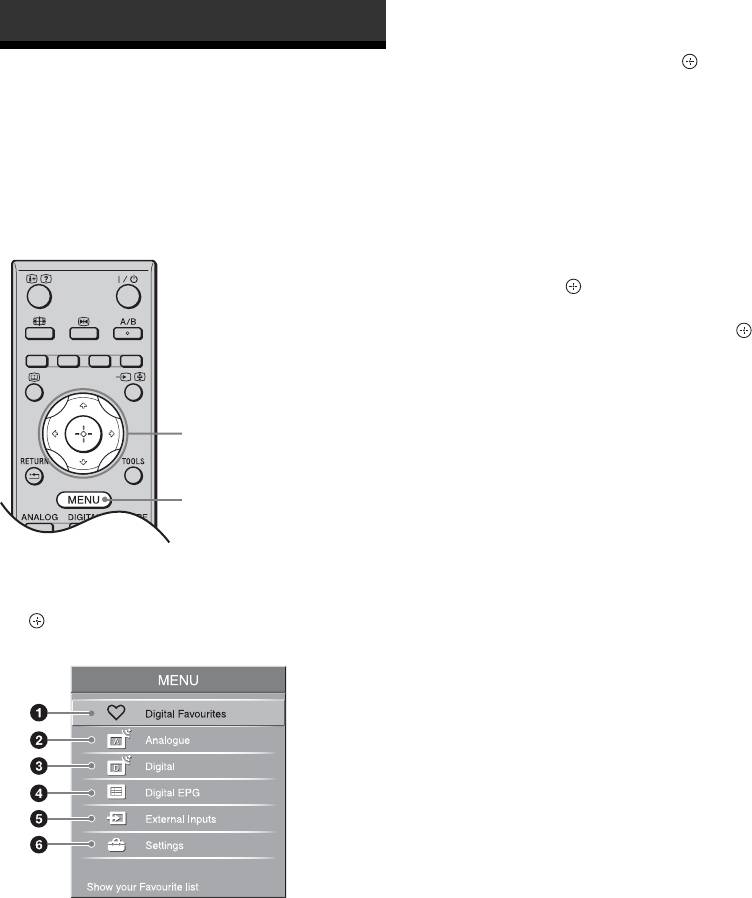
5 External Inputs
Using MENU Functions
Selects equipment connected to your TV.
• To watch the desired external input, select the
input source, then press .
• To assign a label to an external input, select
Navigating through
“Edit AV Labels”, then see page 29.
• To see a list of the connected HDMI control
menus
compatible equipment, select “HDMI Device
Selection”.
“MENU” allows you to enjoy various convenient
6 Settings
features of this TV. You can easily select channels or
Displays the “Settings” menu where most of the
inputs sources and change the settings for your TV.
advanced settings and adjustments are
performed.
1 Press F/f to select a menu icon, then
press .
2 Press F/f/G/g to select an option or
adjust a setting, then press .
For details about settings, see page 23 to 38.
~
The options you can adjust vary depending on the
situation. Unavailable options are greyed out or not
2
displayed.
* This function may not be available in some countries/
regions.
1
1 Press MENU.
2 Press F/f to select an option, then press
.
To exit the menu, press MENU.
1 Digital Favourites*
Displays the Favourite list (page 17).
2 Analogue
Returns to the last viewed analogue channel.
3 Digital*
Returns to the last viewed digital channel.
4 Digital EPG*
Displays the Digital Electronic Programme
Guide (EPG) (page 15).
GB
22
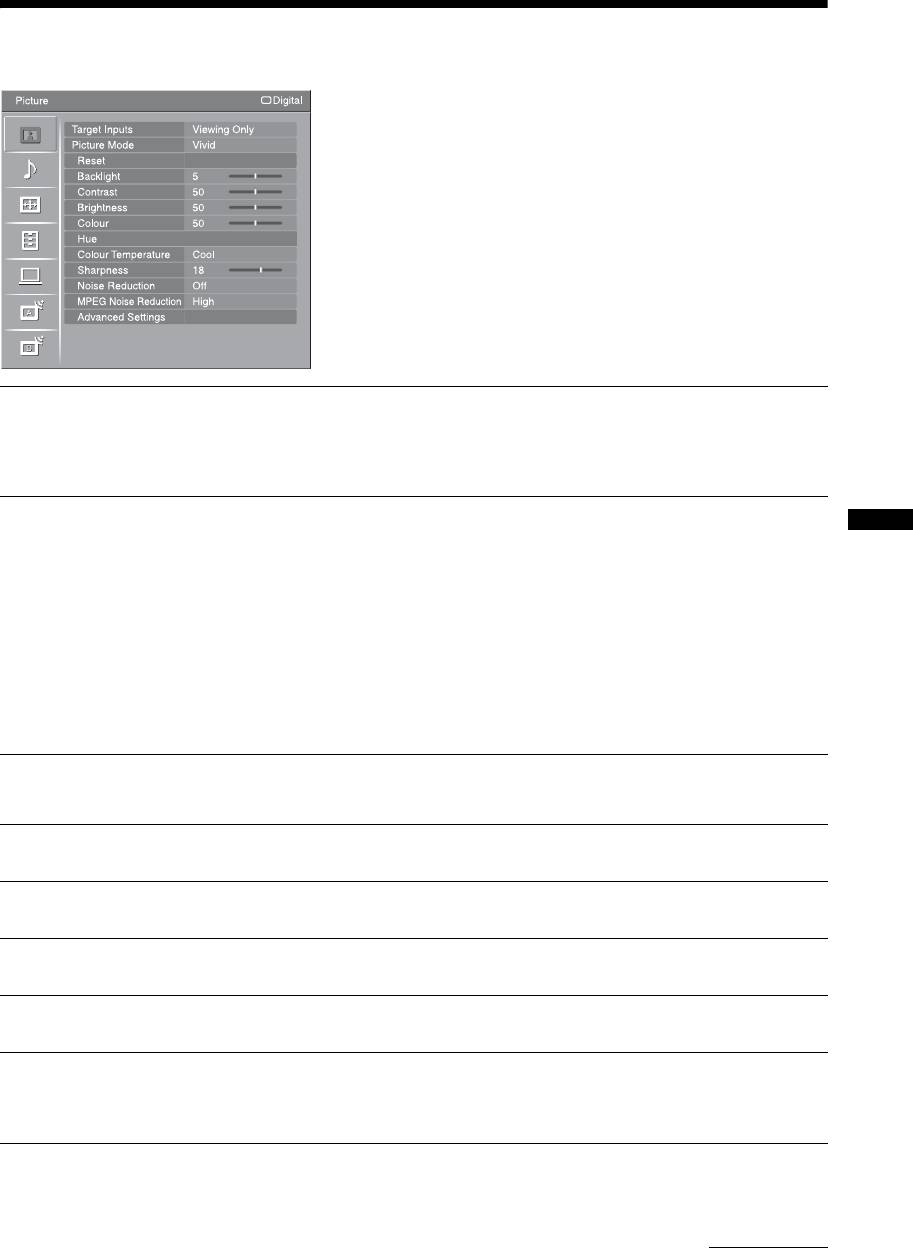
Picture menu
You can select the options listed below on the
“Picture” menu. To select options in “Settings”, refer
to “Navigating through menus” (page 22).
Target Inputs
Selects whether to apply settings made in the “Picture” menu to all inputs, or only to
the input currently being watched.
“All”: Applies settings to all inputs.
“Viewing Only”: Applies settings only to the current input.
Picture Mode
Selects the picture mode except for PC input source. The options for “Picture Mode”
may differ depending on the “Video/Photo” setting (page 28).
Using MENU Functions
“Vivid”: For enhanced picture contrast and sharpness.
“Standard”: For standard picture. Recommended for home entertainment.
“Cinema”: For viewing film-based content. Most suitable for viewing in a theatre-
like environment. This picture setting was developed in collaboration with Sony
Pictures Entertainment to faithfully reproduce movies as intended by their creators.
“Photo”: Sets the optimum picture quality for photographs.
Display Mode
Selects the display mode for PC input source.
“Video”: For video images.
“Text”: For text, charts or tables.
Reset
Resets all the “Picture” settings except “Target Inputs”, “Picture Mode” and
“Display Mode” to the factory settings.
Backlight
Adjusts the brightness of the backlight.
Contrast
Increases or decreases picture contrast.
Brightness
Brightens or darkens the picture.
Colour
Increases or decreases colour intensity.
Hue
Increases or decreases the green tones and red tones.
~
“Hue” can only be adjusted for an NTSC colour signal (e.g. U.S.A. video tapes).
Continued
GB
23

Colour Temperature
Adjusts the whiteness of the picture.
“Cool”: Gives the white colours a blue tint.
“Neutral”: Gives the white colours a neutral tint.
“Warm 1”/“Warm 2”: Gives the white colours a red tint. “Warm 2” gives a redder
tint than “Warm 1”.
z
“Warm 1” and “Warm 2” are not available when “Picture Mode” is set to “Vivid”.
Sharpness
Sharpens or softens the picture.
Noise Reduction
Reduces the picture noise (snowy picture) in a weak broadcast signal.
“Auto”: Automatically reduces the picture noise (in analogue mode only).
“High”/“Medium”/“Low”: Modifies the effect of the noise reduction.
“Off”: Turns off the “Noise Reduction” feature.
MPEG Noise Reduction
Reduces the picture noise in MPEG-compressed video.
Advanced Settings
Customizes the Picture function in more detail. When you set “Picture Mode” to
“Cinema”, “Photo” or “Standard”, you can set/change these settings.
“Reset”: Resets all the advanced settings to the factory settings.
“Black Corrector”: Enhances black areas of the picture for stronger contrast.
“Adv. Contrast Enhancer”: Automatically adjusts “Backlight” and “Contrast” to
the most suitable settings judging from the brightness of the screen. This setting is
especially effective for dark images scenes. It will increase the contrast distinction
of the darker picture scenes.
“Gamma”: Adjusts the balance between bright and dark areas of the picture.
“Clear White”: Emphasizes white colours.
“Live Colour”: Makes colours more vivid.
“Colour Space”: Changes the colour reproduction gamut. “Wide” reproduces the
vivid colour and “Standard” reproduces the standard colour.
GB
24

Sound menu
You can select the options listed below on the
“Sound” menu. To select options in “Settings”, refer
to “Navigating through menus” (page 22).
Target Inputs
Selects whether to apply settings made in the “Sound” menu to all inputs, or only to
the input currently being watched.
“All”: Applies settings to all inputs.
“Viewing Only”: Applies settings only to the current input.
Sound Mode
“Dynamic”: Enhances treble and bass.
“Standard”: For standard sound. Recommended for home entertainment.
Using MENU Functions
“Custom”: Flat response. Also allows you to store your preferred settings.
Reset
Resets all the “Sound” settings except “Target Inputs”, “Sound Mode”, “Dual
Sound”, “i Speaker Link” and “i Dual Sound” to the factory settings.
Treble
Adjusts higher-pitched sounds.
Bass
Adjusts lower-pitched sounds.
Balance
Emphasizes left or right speaker balance.
Auto Volume
Keeps a constant volume level even when volume level gaps occur (e.g. adverts tend
to be louder than programmes).
Volume Offset
Adjusts the volume level of the current input relative to other inputs, when “Target
Inputs” is set to “Viewing Only”.
Surround
“S-FORCE Front Surround”: Available for normal stereo broadcast and 5.1ch
digital broadcast surround audio, and the audio input from connected equipment.
“Off”: Converts and reproduces 5.1ch and other digital broadcast surround audio as
normal stereo audio (2ch). Reproduces the original audio of other broadcasts as is.
Sound Booster
Gives sound more impact by compensating for phase effects in speakers.
Continued
GB
25

Dual Sound
Selects the sound from the speaker for a stereo or bilingual broadcast.
“Stereo”/“Mono”: For a stereo broadcast.
“A”/“B”/“Mono”: For a bilingual broadcast, select “A” for sound channel 1, “B”
for sound channel 2, or “Mono” for a mono channel, if available.
~
If you select other equipment connected to the TV, set “Dual Sound” to “Stereo”, “A” or “B”.
However, when the external equipment connected to the HDMI socket is selected, this is fixed
to “Stereo”.
i Speaker Link
Switches the TV’s internal speakers on/off when headphones are connected.
“On”: Sound is output only from headphones.
“Off”: Sound is output from both the TV and headphones.
i Dual Sound
Selects the sound from the headphone for a stereo or bilingual broadcast, which
depends on the “Dual Sound” selection.
GB
26
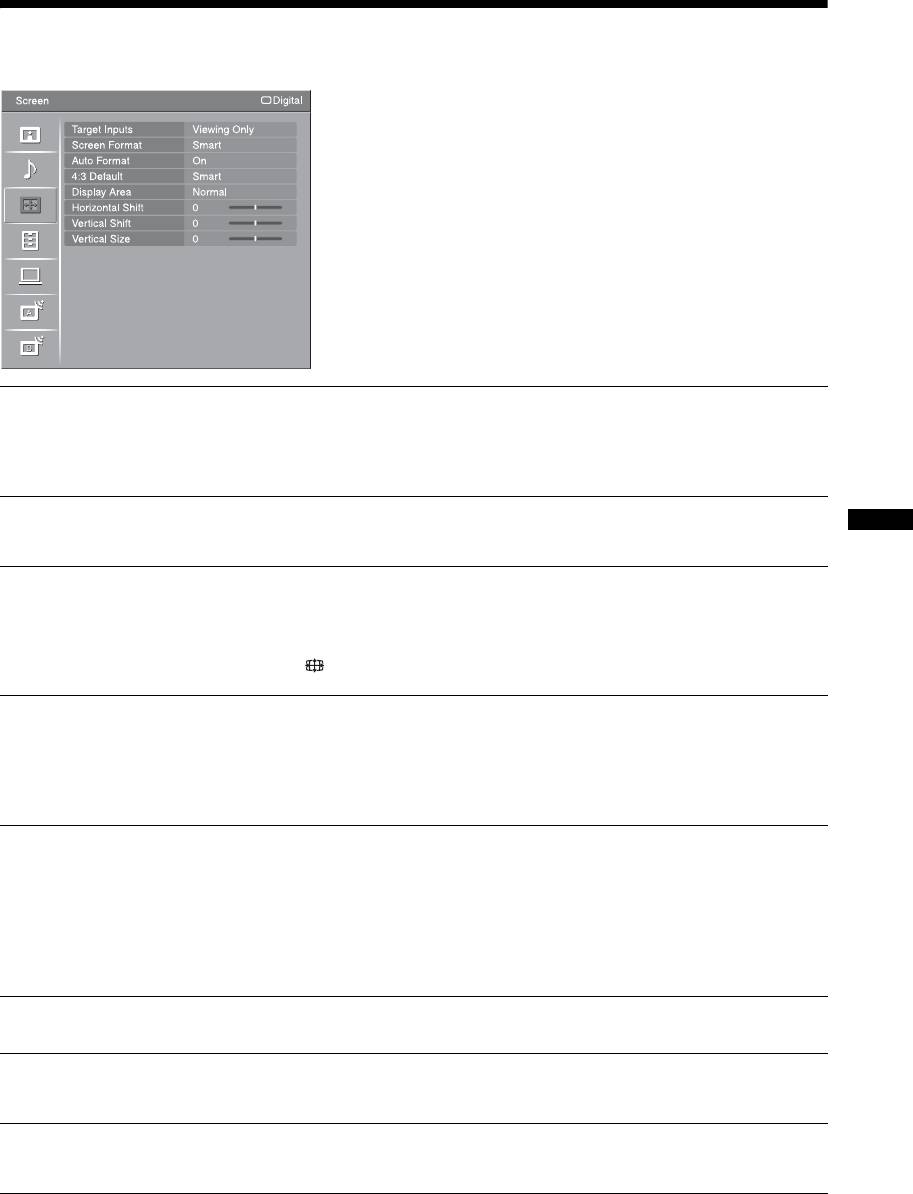
Screen menu
You can select the options listed below on the
“Screen” menu. To select options in “Settings”, refer
to “Navigating through menus” (page 22).
Target Inputs
Selects whether to apply settings made in the “Screen” menu to all inputs, or only to
the input currently being watched.
“All”: Applies settings to all inputs.
“Viewing Only”: Applies settings only to the current input.
Screen Format
For details about the screen format, see “To change the screen format manually to
suit the broadcast” on page 14.
Using MENU Functions
Auto Format
Automatically changes the screen format according to the broadcast signal. To keep
your setting, select “Off”.
z
Even if “Auto Format” is set to “On” or “Off”, you can always modify the format of the screen
by pressing repeatedly.
4:3 Default
Selects the default screen format for use with 4:3 broadcasts.
“Smart”: Displays conventional 4:3 broadcasts with an imitation wide screen effect.
“4:3”: Displays conventional 4:3 broadcasts in the correct proportions.
“Off”: Keeps the current “Screen Format” setting when the channel or input is
changed.
Display Area
Adjusts the screen area for displaying the picture.
“Full Pixel”: Displays the picture for 1080i or 1080p (except for component input)
sources in the original size when parts of the picture are cut off.
“Normal”: Displays the recommended picture area.
“-1”/“-2”: Enlarges the picture to hide the edge of the picture.
~
“Full Pixel” is available only when “Screen Format” is set to “Wide”.
Horizontal Shift
Adjusts the horizontal position of the picture.
Vertical Shift
Adjusts the vertical position of the picture when “Screen Format” is set to “Smart”
(50 Hz), “Zoom” or “14:9”.
Vertical Size
Adjusts the vertical size of the picture when “Screen Format” is set to “Smart”,
“Zoom” or “14:9”.
GB
27
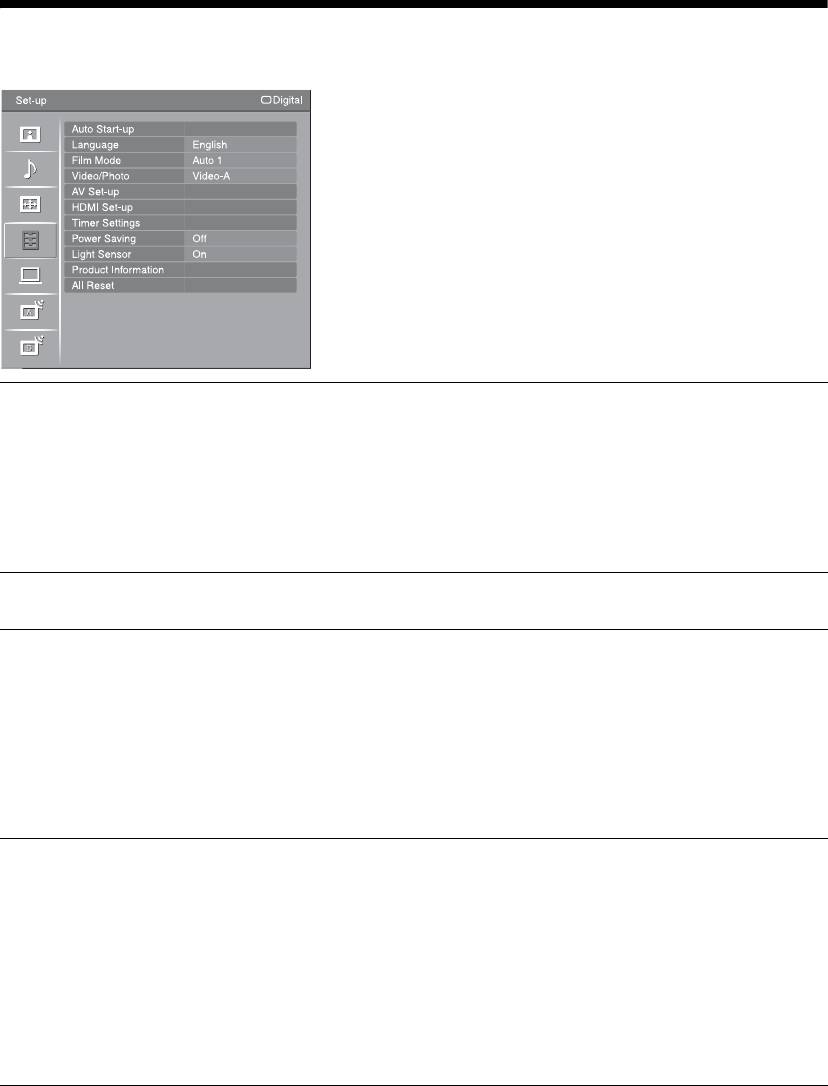
Set-up menu
You can select the options listed below on the “Set-
up” menu. To select options in “Settings”, refer to
“Navigating through menus” (page 22).
Auto Start-up
Starts the initial set-up to select the language and country/region, and tune in all
available digital and analogue channels.
Usually, you do not need to do this operation because the language and country/
region will have been selected and channels already tuned when the TV was first
installed (page 6).
However, this option allows you to repeat the process (e.g. to retune the TV after
moving house, or to search for new channels that have been launched by
broadcasters).
Language
Selects the language in which the menus are displayed.
Film Mode
Provides smoother picture movement when playing DVD or VCR images taken on
film, reducing picture blur and graininess.
“Auto 1”: Provides smoother picture movement than the original film-based
content. Use this setting for standard use.
“Auto 2”: Provides the original film-based content as is.
“Off”: Turns off the “Film Mode” feature.
~
If the image contains irregular signals or too much noise, “Film Mode” will be automatically
turned off even if “Auto 1” or “Auto 2” is selected.
Video/Photo
Provides suitable image quality by selecting the option depending on the input
source (video or photograph data).
“Video-A”: Sets suitable image quality, depending on the input source, video data
or photograph data when directly connecting Sony HDMI output-capable equipment
that supports “Video-A” mode.
“Video”: Produces suitable image quality for moving pictures.
“Photo”: Produces suitable image quality for still images.
~
• The setting is fixed to “Video” when Video-A mode is not supported on the connected
equipment, even if “Video-A” is selected.
• “Video/Photo” is available only for HDMI and component input sources (1080p and 1080i).
GB
28

AV Set-up
AV Preset
Assigns a name to any equipment connected to the side and rear sockets. The name
will be displayed briefly on the screen when the equipment is selected. You can skip
input signals from connected equipment that you do not want displayed on the
screen.
1 Press F/f to select the desired input source, then press .
2 Press
F/f to select the desired option below, then press .
Equipment labels: Uses one of the preset labels to assign a name to connected
equipment.
“Edit:”: Creates your own label. Follow steps 2 to 4 of “Programme Labels”
(page 33).
“Skip”: Skips an unnecessary input source.
Auto S Video
Selects the input signal from S video sockets 6 when / 6 sockets are both
connected.
AV2 Output
Sets a signal to be output through the socket labelled / 2 on the rear of the TV.
If you connect a VCR or other recording equipment to the / 2 socket, you can
then record from the equipment connected to other sockets of the TV.
“TV”: Outputs a broadcast.
“AV1”: Outputs signals from equipment connected to the / 1 socket.
“AV6”: Outputs signals from equipment connected to the
/ 6 socket.
“Auto”: Outputs whatever is being viewed on the screen (except signals from the
/ 3, HDMI IN 4, HDMI IN 5, HDMI IN 7 and PC / sockets).
Using MENU Functions
Speaker
Turns on/off the TV’s internal speakers.
“TV Speaker”: The TV speakers are turned on in order to listen to the TV’s sound
through the TV speakers.
“Audio System”: The TV speakers are turned off in order to listen to the TV’s sound
only through your external audio equipment connected to the audio output sockets.
When connected with an HDMI control compatible equipment, you can turn the
connected equipment on interlocked with the TV. This setting must be made after
connecting the equipment.
Audio Out
“Variable”: The audio output from your audio system can be controlled by the TV’s
remote.
“Fixed”: The audio output of the TV is fixed. Use your audio receiver’s volume
control to adjust the volume (and other audio settings) through your audio system.
Colour System
Selects the colour system (“Auto”, “PAL”, “SECAM”, “NTSC3.58”, “NTSC4.43”
or “PAL60”) according to the input signal from the input source.
Continued
GB
29

HDMI Set-up
This is used to set the HDMI control compatible equipment connected to the HDMI
sockets. Note that the interlock setting must also be made on the connected HDMI
control compatible equipment side.
HDMI Control
Sets whether to interlock the HDMI control compatible equipment and the TV.
When set to “On”, the following menu items can be performed.
Auto Devices Off
When this is set to “On”, the HDMI control compatible equipment turn off
interlocked with the TV.
Auto TV On
When this is set to “On”, the TV turns on interlocked with the HDMI control
compatible equipment.
Device List Update
Creates or updates the “HDMI Device List”. Up to 11 HDMI control compatible
equipment items can be connected, and up to 5 equipment items can be connected to
a single socket. Be sure to update the “HDMI Device List” when you change the
HDMI control compatible equipment connections or settings.
HDMI Device List
Displays the connected HDMI control compatible equipment.
~
You cannot use “HDMI Set-up” when an HDMI control compatible audio system is interlocked
with the TV.
Timer Settings
Sets the timer to turn on/off the TV.
Sleep Timer
Sets a period of time after which the TV automatically switches itself into standby
mode.
When “Sleep Timer” is activated, the (Timer) indicator on the TV front panel
lights up in orange.
z
• If you turn off the TV and turn it on again, “Sleep Timer” is reset to “Off”.
• A notification message appears on the screen one minute before the TV switches to standby
mode.
On Timer
Sets the timer to turn on the TV from standby mode.
“Day”: Selects the day on which you want to activate the “On Timer”.
“Time”: Sets the time to turn on the TV.
“Duration”: Selects the time period after which the TV automatically switches to
standby mode again.
“Volume Set-up”: Sets the volume for when the timer turns on the TV.
Clock Set
Allows you to adjust the clock manually. When the TV is receiving digital channels,
the clock cannot be adjusted manually since it is set to the time code of the
broadcasted signal.
Power Saving
Selects the power saving mode to reduce the power consumption of the TV.
When “Picture Off” is selected, the picture is switched off and the (Picture Off)
indicator on the TV front panel lights up in green. The sound remains unchanged.
GB
30

Light Sensor
“On”: Automatically optimizes the picture settings according to the ambient light in
the room.
“Off”: Turns off the “Light Sensor” feature.
~
Be sure not to put anything over the sensor, as its function may be affected. See page 12 for
further information on the sensor.
Product Information
Displays your TV’s product information.
All Reset
Resets all settings to the factory settings and then displays the “Auto Start-up”
screen.
~
• Be sure not to turn the TV off during this period (it takes about 30 seconds) or press any
buttons.
• All settings, including Digital Favourite list, country/region, language, auto tuned channels,
etc. will be reset.
Using MENU Functions
GB
31

PC Settings menu
You can select the options listed below on the “PC
Settings” menu. To select options in “Settings”, refer
to “Navigating through menus” (page 22).
Screen Format
Selects a screen format for displaying input from your PC.
“Normal”: Displays the picture in its original size.
“Full 1”: Enlarges the picture to fill the display area, keeping its original horizontal-
to-vertical aspect ratio.
“Full 2”: Enlarges the picture to fill the display area.
Reset
Resets the PC settings except “Screen Format” and “Power Management” to the
factory settings.
Auto Adjustment
Automatically adjusts the display position and phase of the picture when the TV
receives an input signal from the connected PC.
z
“Auto Adjustment” may not work well with certain input signals. In such cases, manually
adjust “Phase”, “Horizontal Shift” and “Vertical Shift”.
Phase
Adjusts the phase when the screen flickers.
Pitch
Adjusts the pitch when the picture has unwanted vertical stripes.
Horizontal Shift
Adjusts the horizontal position of the picture.
Vertical Shift
Adjusts the vertical position of the picture.
Power Management
Switches the TV to standby mode if no signal is received for 30 seconds.
GB
32
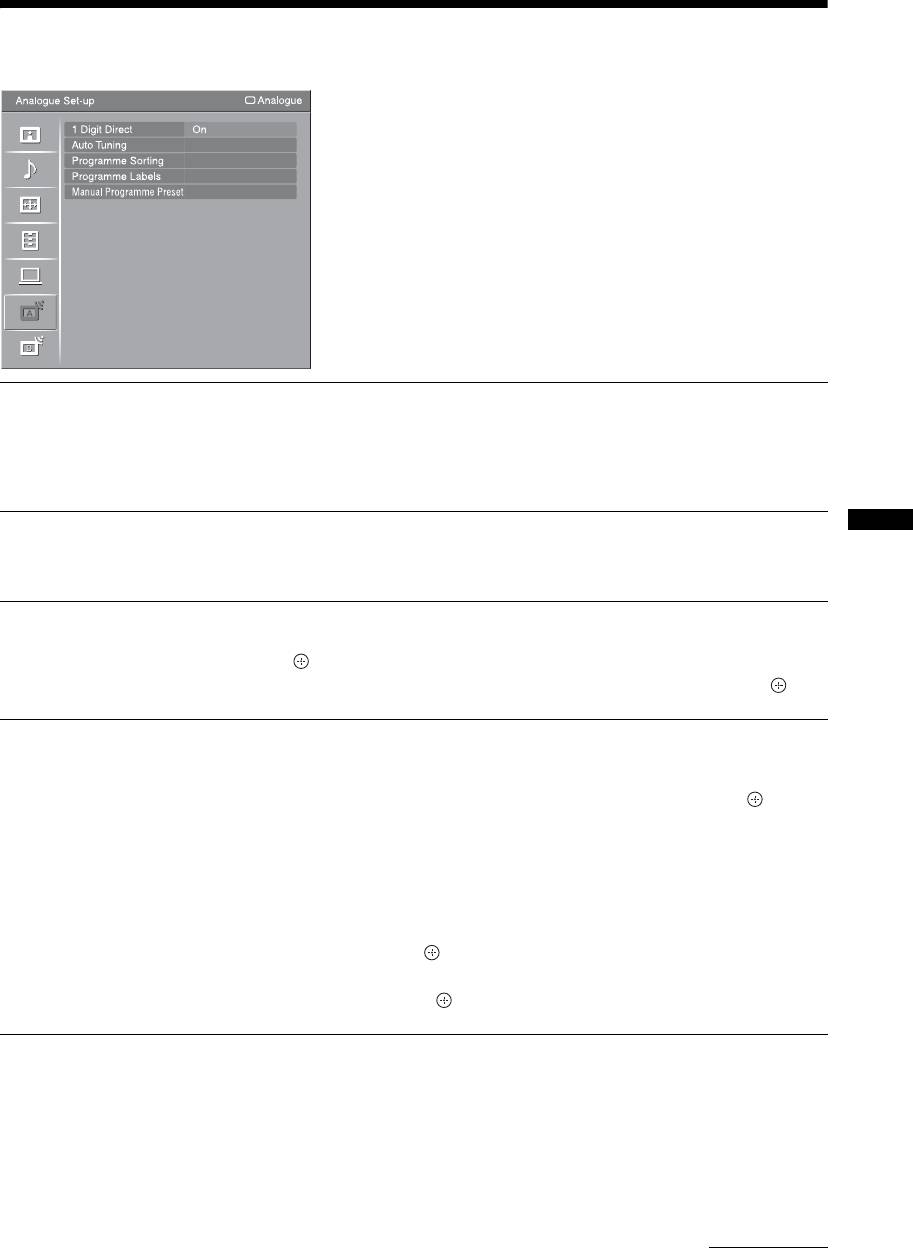
Analogue Set-up menu
You can select the options listed below on the
“Analogue Set-up” menu. To select options in
“Settings”, refer to “Navigating through menus”
(page 22).
1 Digit Direct
When “1 Digit Direct” is set to “On”, you can select an analogue channel using one
preset number button (0 - 9) on the remote.
~
When “1 Digit Direct” is set to “On”, you cannot select channel numbers 10 and above entering
two digits using the remote.
Auto Tuning
Tunes in all the available analogue channels.
This option allows you to retune the TV after moving house, or to search for new
Using MENU Functions
channels that have been launched by broadcasters.
Programme Sorting
Changes the order in which the analogue channels are stored on the TV.
1 Press
F/f to select the channel you want to move to a new position, then
press .
2 Press
F/f to select the new position for your channel, then press .
Programme Labels
Assigns a channel name of your choice up to five letters or numbers. The name will
be displayed briefly on the screen when the channel is selected. (Names for channels
are usually taken automatically from Text (if available).)
1 Press
F/f to select the channel you want to name, then press .
2 Press
F/f to select the desired letter or number (“_” for a blank space),
then press
g.
If you input a wrong character
Press G/g to select the wrong character. Then, press F/f to select the correct
character.
To delete all the characters
Select “Reset”, then press .
3 Repeat the procedure in step 2 until the name is completed.
4 Select “OK”, then press .
Continued
GB
33

Manual Programme
Before selecting “Label”/“AFT”/“LNA”/“Audio Filter”/“Skip”/“Decoder”, press
PROG +/- to select the programme number with the channel. You cannot select a
Preset
programme number that is set to “Skip” (page 35).
Programme/System/Channel
Presets programme channels manually.
1 Press
F/f to select “Programme”, then press .
2 Press
F/f to select the programme number you want to manually tune (if
tuning a VCR, select channel 00), then press RETURN.
3 Press F/f to select “System”, then press .
4 Press
F/f to select one of the following TV broadcast systems, then
press RETURN.
B/G: For western European countries/regions
I: For the United Kingdom
D/K: For eastern European countries/regions
L: For France
5 Press F/f to select “Channel”, then press .
6 Press
F/f to select “S” (for cable channels) or “C” (for terrestrial
channels), then press
g.
7 Tune the channels as follows:
If you do not know the channel number (frequency)
Press F/f to search for the next available channel. When a channel has been found,
the search will stop. To continue searching, press
F/f.
If you know the channel number (frequency)
Press the number buttons to enter the channel number of the broadcast you want or your
VCR channel number.
8 Press to jump to “Confirm”, then press .
9 Press
f to select “OK”, then press .
Repeat the procedure above to preset other channels manually.
Label
Assigns a name of your choice, up to five letters or numbers, to the selected channel.
This name will be displayed briefly on the screen when the channel is selected.
To input characters, follow steps 2 to 4 of “Programme Labels” (page 33).
AFT
Allows you to fine-tune the selected programme number manually if you feel that a
slight tuning adjustment will improve the picture quality.
You can adjust the fine tuning over a range of -15 to +15. When “On” is selected, the
fine tuning is performed automatically.
LNA
Improves the picture quality for individual channels in the case of very weak
broadcast signals (noisy picture).
If you cannot see any improvement in the picture quality even if you set to “On”, set
this option to “Off” (factory setting).
Audio Filter
Improves the sound for individual channels in the case of distortion in mono
broadcasts. Sometimes a non-standard broadcast signal can cause sound distortion or
intermittent sound muting when watching mono programmes.
If you do not experience any sound distortion, we recommend that you leave this
option set to the factory setting “Off”.
~
You cannot receive stereo or dual sound when “Low” or “High” is selected.
GB
34

Skip
Skips unused analogue channels when you press PROG +/- to select channels. (You
can still select a skipped channel using the number buttons.)
Decoder
Shows and records the scrambled channel selected when using a decoder connected
directly to scart connector / 1, or to scart connector / 2 via a VCR.
~
Depending on the country/region selected for “Country” (page 6), this option may not be
available.
Confirm
Saves changes made to the “Manual Programme Preset” settings.
Using MENU Functions
GB
35
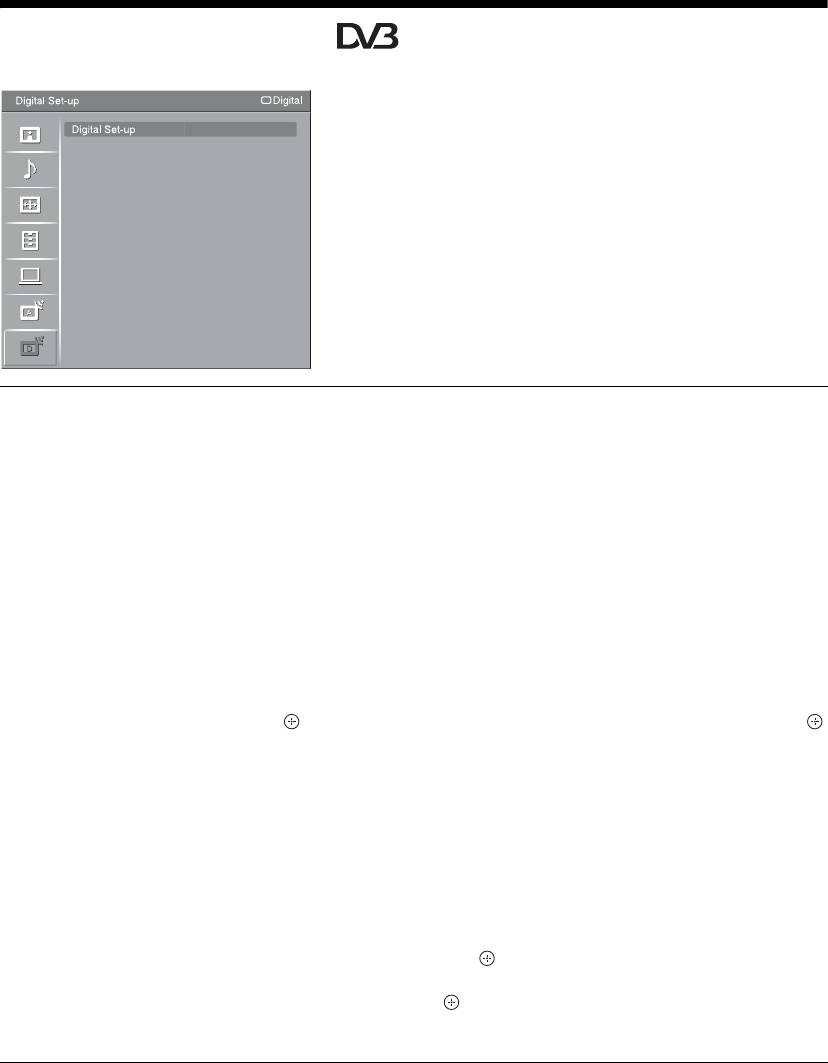
Digital Set-up menu
You can select the options listed below on the “Digital
Set-up” menu. To select options in “Settings”, refer to
“Navigating through menus” (page 22).
~
Some functions may not be available in some countries/
regions.
Digital Tuning
Digital Auto Tuning
Tunes in the available digital channels.
This option allows you to retune the TV after moving house, or to search for new
channels that have been launched by broadcasters. For details, see “Auto tuning the
TV” on page 6.
Programme List Edit
Removes any unwanted digital channels stored on the TV, and changes the order of
the digital channels stored on the TV.
1 Press
F/f to select the channel you want to remove or move to a new
position.
Press the number buttons to enter the known three-digit programme number of the
broadcast you want.
2 Remove or change the order of the digital channels as follows:
To remove the digital channel
Press . After a confirmation message appears, press G to select “Yes”, then press .
To change the order of the digital channels
Press g, then press F/f to select the new position for the channel and press G.
3 Press RETURN.
Digital Manual Tuning
Tunes the digital channels manually. This feature is available when “Digital Auto
Tuning” is set to “Antenna”.
1 Press the number button to select the channel number you want to
manually tune, then press
F/f to tune the channel.
2 When the available channels are found, press
F/f to select the channel
you want to store, then press .
3 Press F/f to select the programme number where you want to store the
new channel, then press .
Repeat the above procedure to manually tune other channels.
GB
36

Digital Set-up
Subtitle Set-up
“Subtitle Setting”: When “For Hard Of Hearing” is selected, some visual aids may
also be displayed with the subtitles (if TV channels broadcast such information).
“Subtitle Language”: Selects which language subtitles are displayed in.
Audio Set-up
“Audio Type”: Switches to broadcast for the hearing impaired when “For Hard Of
Hearing” is selected.
“Audio Language”: Selects the language used for a programme. Some digital
channels may broadcast several audio languages for a programme.
“Audio Description”: Provides audio description (narration) of visual information,
if TV channels broadcast such information.
“Mixing Level”: Adjusts the TV main audio and Audio Description output levels.
Banner Mode
“Basic”: Displays programme information with a digital banner.
“Full”: Displays programme information with a digital banner, and displays detailed
programme information below that banner.
Radio Display
The screen wallpaper is displayed when listening to a radio broadcast. You can select
the screen wallpaper colour, or display a random colour. To cancel the screen
wallpaper display temporarily, press any button.
Parental Lock
Sets an age restriction for programmes. Any programme that exceeds the age
restriction can only be watched after a PIN Code is entered correctly.
Using MENU Functions
1 Press the number buttons to enter your existing PIN code.
If you have not previously set a PIN, a PIN code entry screen appears. Follow the
instructions of “PIN Code” below.
2 Press F/f to select the age restriction or “None” (for unrestricted
watching), then press .
3 Press RETURN.
PIN Code
To set your PIN for the first time
1 Press the number buttons to enter the new PIN code.
2 Press RETURN.
To change your PIN
1 Press the number buttons to enter your existing PIN code.
2 Press the number buttons to enter the new PIN code.
3 Press RETURN.
z
PIN code 9999 is always accepted.
Technical Set-up
“Auto Service Update”: Enables the TV to detect and store new digital services as
they become available.
“Software Download”: Enables the TV to automatically receive software updates
free through your existing aerial/cable (when issued). It is recommended that this
option be set to “On” at all times. If you do not want your software to be updated, set
this option to “Off”.
“System Information”: Displays the current software version and the signal level.
“Time Zone”: Allows you to manually select the time zone you are in, if it is not the
same as the default time zone setting for your country/region.
Continued
GB
37

“Auto DST”: Sets whether or not to automatically switch between summer time and
winter time.
• “Off”: The time is displayed according to the time difference set by “Time Zone”.
• “On”: Automatically switches between summer time and winter time according to the
calendar.
CA Module Set-up
Allows you to access a pay TV service once you obtain a Conditional Access Module
(CAM) and a view card. See page 18 for the location of the (PCMCIA) socket.
GB
38
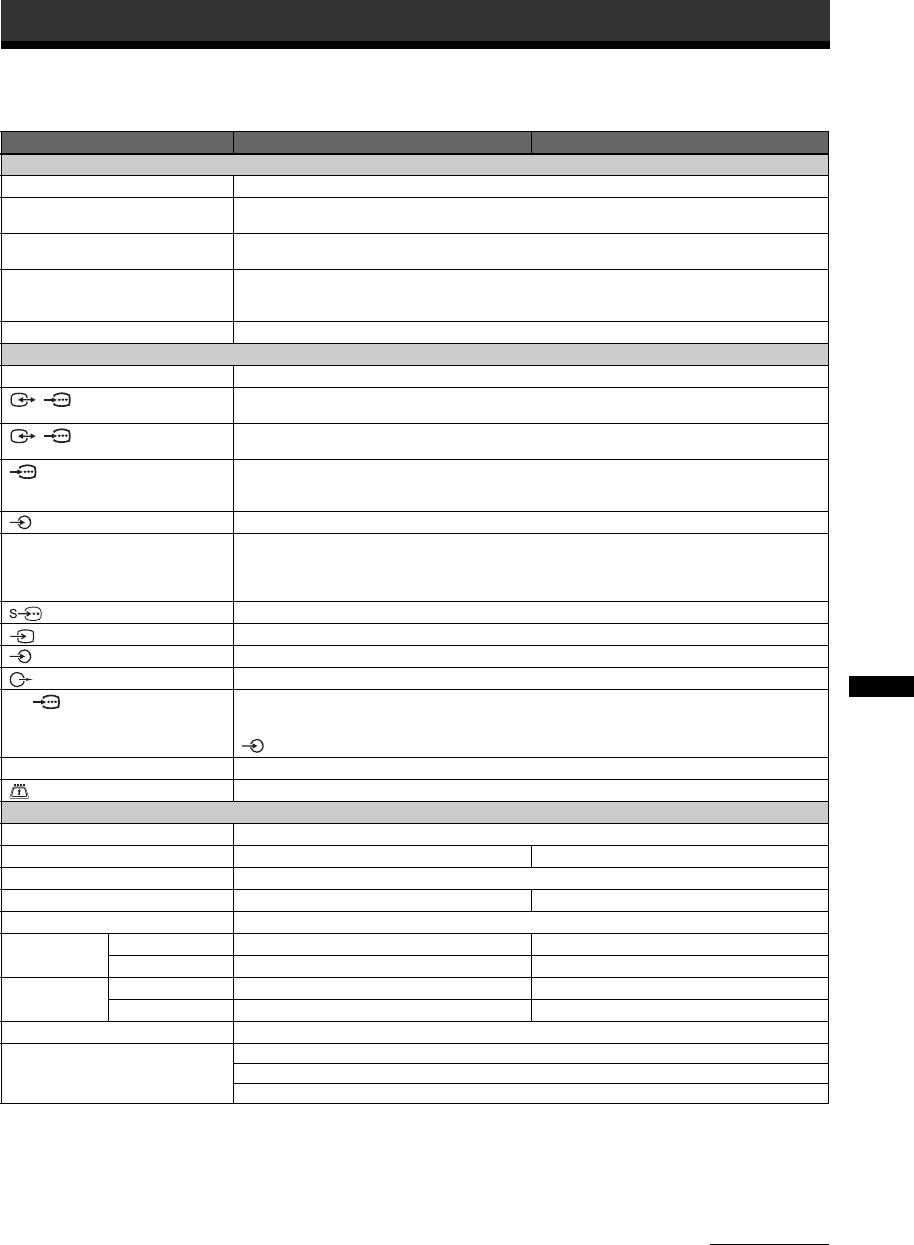
Additional Information
Specifications
Model name KDL-40V3000 KDL-46V3000
System
Panel System
LCD (Liquid Crystal Display) Panel
TV System
Analogue: Depending on your country/region selection: B/G/H, D/K, L, I
Digital: DVB-T/DVB-C
Colour/Video System
Analogue: PAL, SECAM, NTSC 3.58, 4.43 (only Video In)
Digital: MPEG-2 MP@ML
Channel Coverage
Analogue: VHF: E2–E12/UHF: E21–E69/CATV: S1–S20/HYPER: S21–S41
D/K: R1–R12, R21–R69/L: F2–F10, B–Q, F21–F69/I: UHF B21–B69
Digital: VHF/UHF
Sound Output
10 W + 10 W
Input/Output jacks
Aerial/Cable
75 ohm external terminal for VHF/UHF
/1
21-pin scart connector (CENELEC standard) including audio/video input, RGB input, and TV audio/
video output.
/2 (SmartLink)
21-pin scart connector (CENELEC standard) including audio/video input, RGB input, selectable audio/
video output, and SmartLink interface.
3
Supported formats: 1080p, 1080i, 720p, 576p, 576i, 480p, 480i
Y: 1 Vp-p, 75 ohms, 0.3V negative sync/P
B/CB: 0.7 Vp-p, 75 ohms/
P
R/CR: 0.7 Vp-p, 75 ohms
3
Audio input (phono jacks): 500 mVrms, Impedance: 47 kilohms
HDMI IN 4, 5, 7
Video: 1080/24p, 1080p, 1080i, 720p, 576p, 576i, 480p, 480i
Audio: Two channel linear PCM
32, 44.1 and 48 kHz, 16, 20 and 24 bits
Analogue audio input (phono jacks): 500 mVrms, Impedance: 47 kilohms (HDMI IN 5 only)
6
S video input (4-pin mini DIN)
6
Video input (phono jack)
6
Audio input (phono jacks)
DIGITAL OUT (OPTICAL) (digital optical jack)/Audio output (phono jacks)
PC
PC Input (D-sub 15-pin) (see page 40)
G: 0.7 Vp-p, 75 ohms, non Sync on Green/B: 0.7 Vp-p, 75 ohms/
Additional Information
R: 0.7 Vp-p, 75 ohms/HD: 1-5 Vp-p/VD: 1-5 Vp-p
PC audio input (minijack)
i
Headphones jack
CAM (Conditional Access Module) slot
Power and others
Power Requirements
220–240 V AC, 50 Hz
Screen Size
40 inches (Approx. 101.6 cm measured diagonally) 46 inches (Approx. 116.8 cm measured diagonally)
Display Resolution
1,920 dots (horizontal) × 1,080 lines (vertical)
Power Consumption
193 W 238 W
Standby Power Consumption*
0.3 W
Dimensions
(with stand)
Approx. 992 × 688 × 265 mm Approx. 1,135 × 779 × 306 mm
(w × h × d)
(without stand)
Approx. 992 × 643 × 122 mm Approx. 1,135 × 734 × 122 mm
Mass (with stand)
Approx. 24.0 kg Approx. 30.5 kg
(without stand)
Approx. 20.5 kg Approx. 26.5 kg
Supplied Accessories
Refer to “1: Checking the accessories” on page 4.
Optional Accessories
Wall-Mount Bracket SU-WL500
Floor stand SU-FL62
TV stand SU-FL300M
* Specified standby power is reached after the TV finishes necessary internal processes.
Design and specifications are subject to change without notice.
Continued
GB
39

PC Input Signal Reference Chart
Horizontal
Vertical
Signals Horizontal (Pixel) Vertical (Line)
frequency
Standard
frequency (Hz)
(kHz)
VGA 640 480 31.5 60 VGA
640 480 37.5 75 VESA
720 400 31.5 70 VGA-T
SVGA 800 600 37.9 60 VESA Guidelines
800 600 46.9 75 VESA
XGA 1024 768 48.4 60 VESA Guidelines
1024 768 56.5 70 VESA
1024 768 60 75 VESA
WXGA 1280 768 47.4 60 VESA
1280 768 47.8 60 VESA
1360 768 47.7 60 VESA
• This TV’s PC input does not support Sync on Green or Composite Sync.
• This TV’s PC input does not support interlaced signals.
• For the best picture quality, it is recommended to use the signals (boldfaced) in the above chart with a 60 Hz vertical frequency
from a personal computer. In plug and play, signals with a 60 Hz vertical frequency will be selected automatically.
GB
40
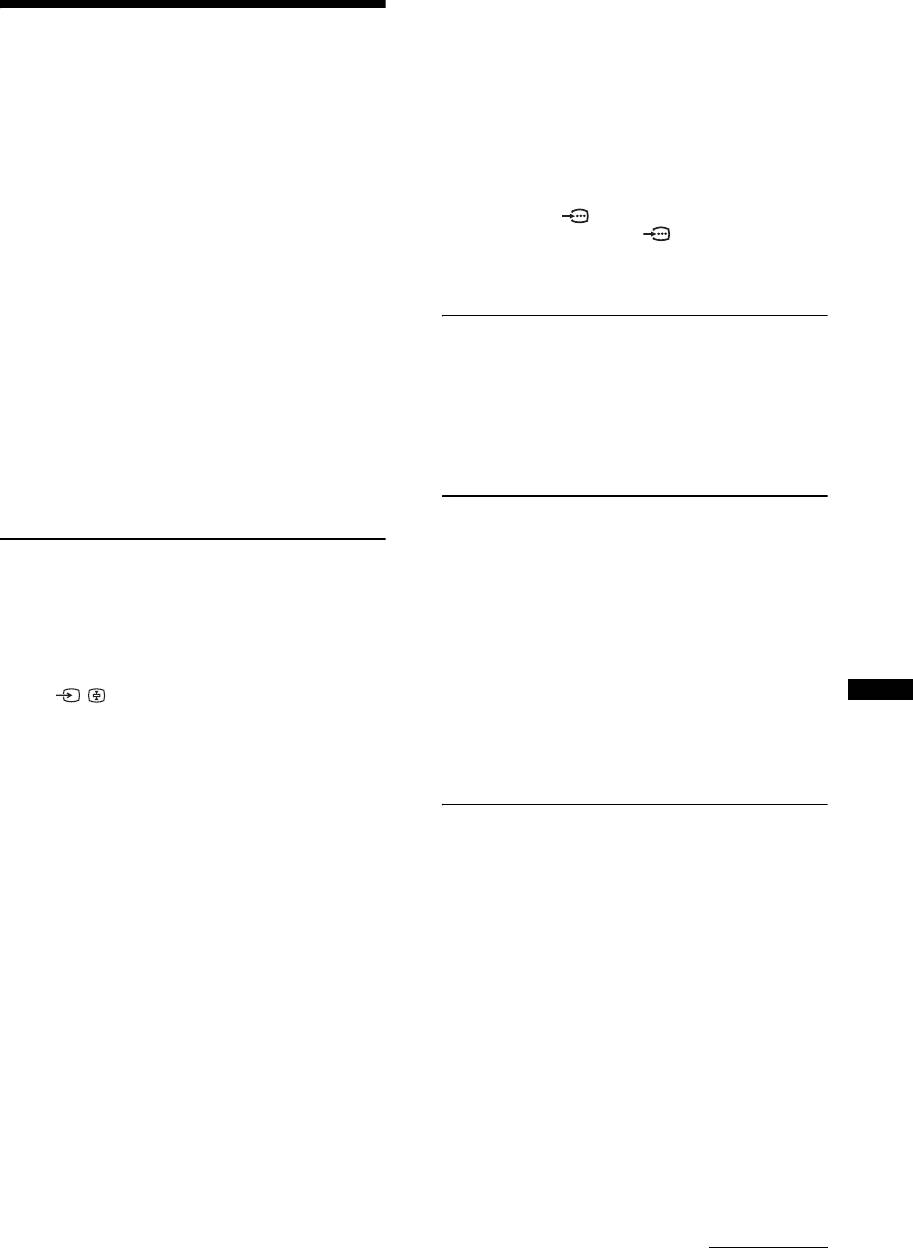
Some tiny black points and/or bright points appear
on the screen
Troubleshooting
• The picture of a display unit is composed of pixels. Tiny
black points and/or bright points (pixels) on the screen do
not indicate a malfunction.
Check whether the 1 (standby) indicator is
The picture contours are disrupted
flashing in red.
• Select “Auto 1” or “Auto 2” in “Film Mode” (page 28).
No colour on programmes
When it is flashing
• Select “Reset” (page 23).
The self-diagnosis function is activated.
No colour or irregular colour when viewing a
1 Count how many 1 (standby) indicator
signal from the 3 sockets
flashes between each two second break.
• Check the connection of the 3 sockets and check if
For example, the indicator flashes three times, then
each sockets are firmly seated in their respective sockets.
there is a two second break, followed by another
three flashes, etc.
Sound
2 Press 1 on the top edge of the TV to turn it
off, disconnect the mains lead, and inform
No sound, but good picture
your dealer or Sony service centre of how
• Press 2 +/– or % (Mute).
the indicator flashes (number of flashes).
• Check if the “Speaker” is set to “TV Speaker” (page 29).
• When using HDMI input with Super Audio CD or DVD-
When it is not flashing
Audio, DIGITAL OUT (Optical) may not provide audio
1 Check the items in the tables below.
signal.
2 If the problem still persists, have your TV
serviced by qualified service personnel.
Channels
Picture
The desired channel cannot be selected
• Switch between digital and analogue mode and select the
No picture (screen is dark) and no sound
desired digital/analogue channel.
• Check the aerial/cable connection.
Some channels are blank
• Connect the TV to the mains, and press 1 on the top edge
• Scrambled/Subscription only channel. Subscribe to the
of the TV.
pay TV service.
• If the 1 (standby) indicator lights up in red, press "/1.
• Channel is used only for data (no picture or sound).
No picture or no menu information from equipment
• Contact the broadcaster for transmission details.
connected to the scart connector
Digital channels are not displayed
• Press / to display the connected equipment list,
• Contact a local installer to find out if digital transmissions
then select the desired input.
Additional Information
are provided in your area.
• Check the connection between the optional equipment and
• Upgrade to a higher gain aerial.
the TV.
Double images or ghosting
General
• Check the aerial/cable connection.
• Check the aerial location and direction.
The TV turns off automatically (the TV enters
Only snow and noise appear on the screen
standby mode)
• Check if the aerial is broken or bent.
• Check if the “Sleep Timer” is activated, or confirm the
• Check if the aerial has reached the end of its serviceable
“Duration” setting of “On Timer” (page 30).
life (three to five years in normal use, one to two years at
• If no signal is received and no operation is performed in
the seaside).
the TV mode for 10 minutes, the TV automatically
switches to standby mode.
Distorted picture (dotted lines or stripes)
• Keep the TV away from electrical noise sources such as
The TV turns on automatically
cars, motorcycles, hair-dryers or optical equipment.
• Check if the “On Timer” is activated (page 30).
• When installing optional equipment, leave some space
Some input sources cannot be selected
between the optional equipment and the TV.
• Select “AV Preset” and cancel “Skip” of the input source
• Make sure that the aerial/cable is connected using the
(page 29).
supplied coaxial cable.
• Keep the aerial/cable TV cable away from other
The remote does not function
connecting cables.
• Replace the batteries.
Picture or sound noise when viewing a TV channel
The “Store Display Mode: On” message appears
• Adjust “AFT” (Automatic Fine Tuning) to obtain better
on the screen
picture reception (page 34).
• Select “All Reset” in the “Set-up” menu (page 31).
Continued
GB
41
HDMI equipment does not appear on “HDMI Device
List”
• Check that your equipment is HDMI control compatible
equipment.
Not all channels are tuned
• Check support web site for cable provide information.
http://support.sony-europe.com/TV/DVBC/
GB
42

Additional Information
GB
43
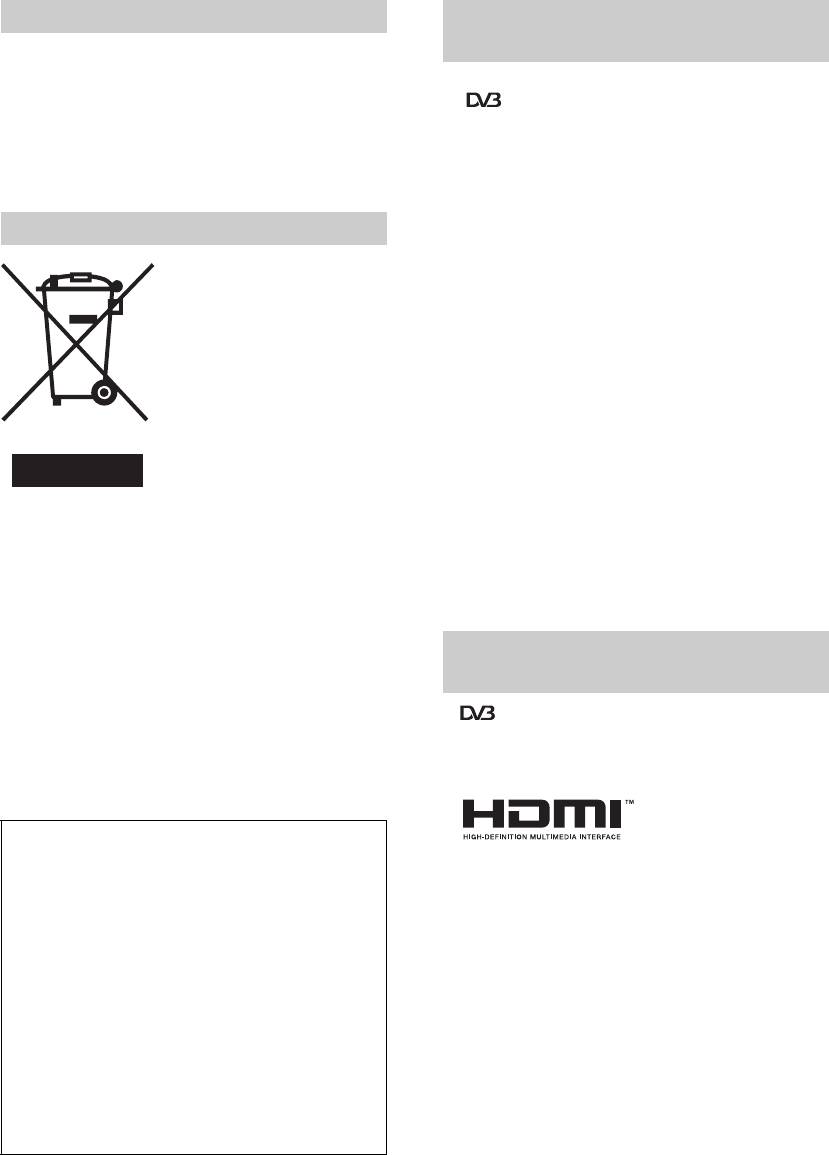
Wprowadzenie
Uwaga dotycząca funkcji TV
cyfrowej
Dziękujemy, że Państwo wybrali produkt firmy
Sony.
• Wszystkie funkcje dotyczące telewizji cyfrowej
Przed rozpoczęciem eksploatacji tego telewizora
( ) są dostępne tylko w krajach lub regionach, w
należy dokładnie zapoznać się z treścią niniejszej
których nadawane są cyfrowe sygnały naziemne
instrukcji oraz zachować ją do wykorzystania w
DVB-T (MPEG2) lub gdzie dostępna jest
przyszłości.
kompatybilna usługa DVB-C (MPEG2) sieci
kablowej. Należy poinformować się u sprzedawcy
sprzętu, czy na danym terenie odbierany jest sygnał
DVB-T, lub zapytać operatora sieci kablowej czy
oferowana usługa DVB-C jest odpowiednia dla
Utylizacja telewizora
zintegrowanych operacji z tym odbiornikiem TV.
• Operator sieci kablowej może żądać dodatkowej
Pozbycie się zużytego
opłaty za takie usługi i może wystąpić konieczność
sprzętu (stosowane w
wyrażenia zgody na ich warunki i postanowienia
krajach Unii Europejskiej
umowy.
i w pozostałych krajach
• Ten odbiornik TV jest wykonany według specyfikacji
europejskich
DVB-T i DVB-C, jednak nie gwarantuje się jego
stosujących własne
kompatybilności z przyszłymi programami cyfrowej
systemy zbiórki)
naziemnej telewizji DVB-T i cyfrowej kablowej
telewizji DVB-C.
Ten symbol na produkcie lub
• Niektóre funkcje telewizji cyfrowej mogą być
jego opakowaniu oznacza, że
niedostępne w niektórych krajach/regionach, a kabel
produkt nie może być
DVB-C może działać nieprawidłowo w wypadku
traktowany jako odpad
niektórych operatorów.
komunalny, lecz powinno się go
dostarczyć do odpowiedniego
Wykaz kompatybilnych operatorów sieci kablowych
punktu zbiórki sprzętu elektrycznego i elektronicznego,
znajduje się w witrynie pomocy technicznej;
w celu recyklingu. Odpowiednie zadysponowanie
http://support.sony-europe.com/TV/DVBC/
zużytego produktu zapobiega potencjalnym
negatywnym wpływom na środowisko oraz zdrowie
ludzi, jakie mogłyby wystąpić w przypadku
niewłaściwego zagospodarowania odpadów. Recykling
materiałów pomoże w ochronie środowiska
naturalnego. W celu uzyskania bardziej szczegółowych
Informacje dotyczące znaków
informacji na temat recyklingu tego produktu, należy
skontaktować się z lokalną jednostką samorządu
towarowych
terytorialnego, ze służbami zagospodarowywania
odpadów lub ze sklepem, w którym zakupiony został ten
• is a registered trademark of the DVB Project
produkt.
• HDMI, logo HDMI i High-Definition Multimedia
Interface są znakami towarowymi lub zastrzeżonymi
znakami towarowymi firmy HDMI Licensing LLC.
Producentem tego produktu jest Sony
Corporation, 1-7-1 Konan Minato-ku Tokyo,
108-0075 Japonia. Upoważnionym
Ilustracje używane w tej instrukcji obsługi
przedstawicielem producenta w Unii
przedstawiają model KDL-40V3000, jeżeli nie
Europejskiej, uprawnionym do dokonywania i
stwierdzono inaczej.
potwierdzania oceny zgodności z wymaganiami
zasadniczymi, jest Sony Deutschland GmbH,
Hedelfinger Strasse 61, 70327 Stuttgart,
Niemcy. Nadzór nad dystrybucją na terytorium
Rzeczypospolitej Polskiej sprawuje Sony
Poland, 00-876 Warszawa, ul. Ogrodowa 58. W
sprawach serwisowych i gwarancyjnych należy
kontaktować się z podmiotami, których adresy
podano w osobnych dokumentach
gwarancyjnych lub serwisowych, lub z
najbliższym sprzedawcą produktów Sony.
PL
2
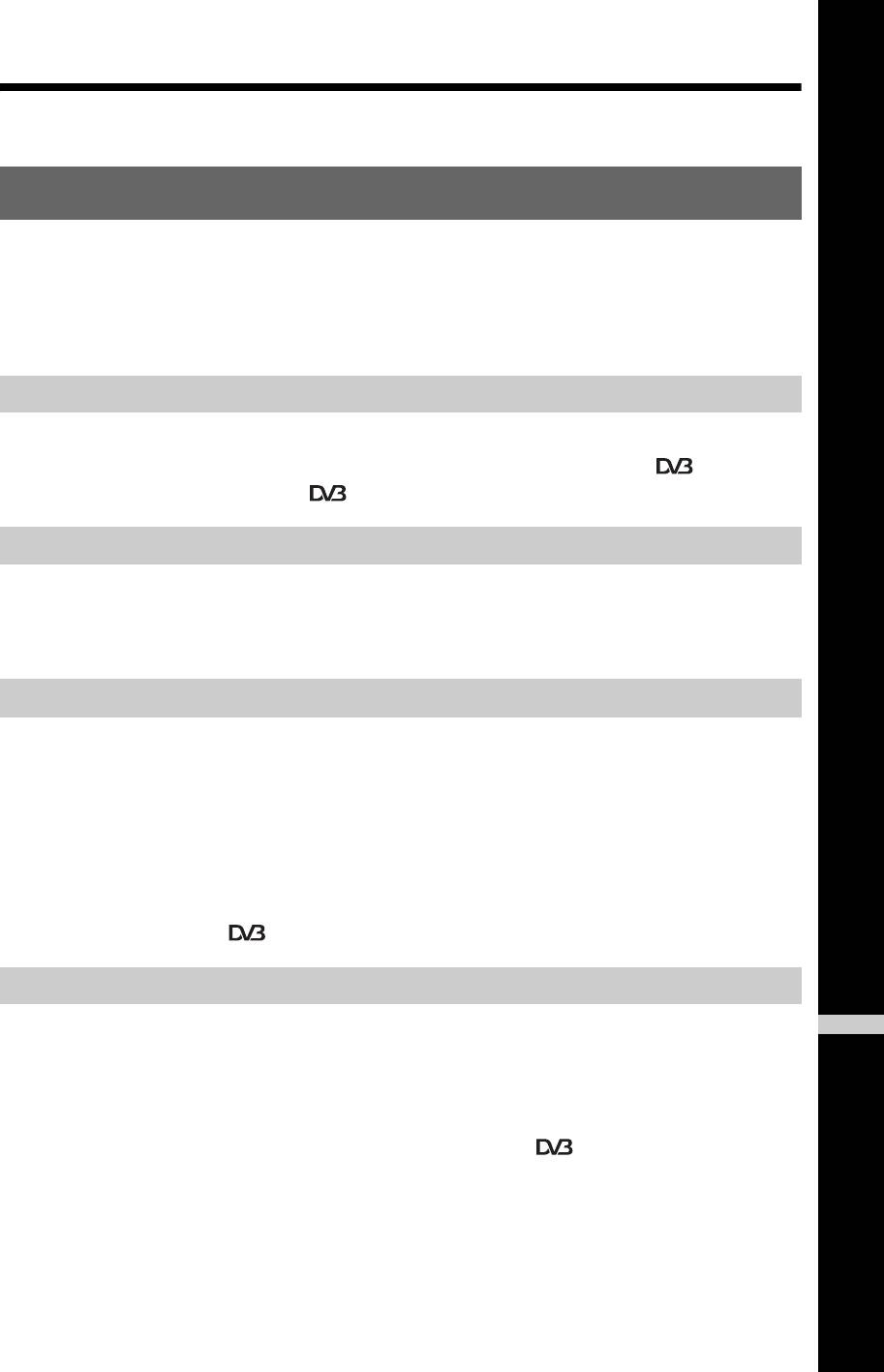
Spis treści
Informacje i czynności wstępne 4
Informacje dotyczące bezpieczeństwa.....................................................................................9
Środki ostrożności ..................................................................................................................11
Przegląd pilota ......................................................................................................................12
Przegląd przycisków i wskaźników odbiornika TV............................................................13
Odbiór audycji telewizyjnych
Odbiór audycji telewizyjnych ..................................................................................................14
Sprawdzanie Cyfrowego elektronicznego informatora programowego (EPG) ...............17
Używanie cyfrowej listy Ulubionych ................................................................................19
Korzystanie z dodatkowego sprzętu
Podłączanie dodatkowego sprzętu.........................................................................................20
Oglądanie obrazów z podłączonych urządzeń .......................................................................22
Używanie sterowania HDMI....................................................................................................23
Używanie funkcji MENU
Nawigacja w menu..................................................................................................................24
Menu Obraz ............................................................................................................................25
Menu Dźwięk...........................................................................................................................27
Menu Ustawienia ekranu.........................................................................................................29
Menu Ustawienia ....................................................................................................................30
Menu Ustawienia PC...............................................................................................................34
Menu Ustawienia analogowe ..................................................................................................35
Menu Ustawienia cyfrowe ...............................................................................................38
Informacje dodatkowe
PL
Dane techniczne .....................................................................................................................41
Rozwiązywanie problemów ....................................................................................................43
: tylko dla kanałów cyfrowych
PL
3

